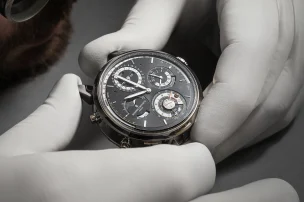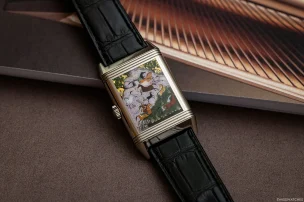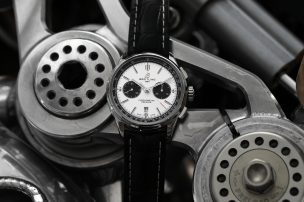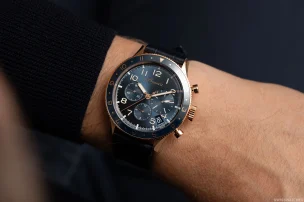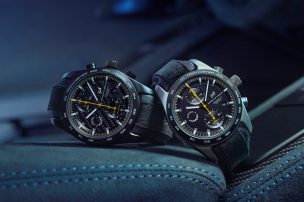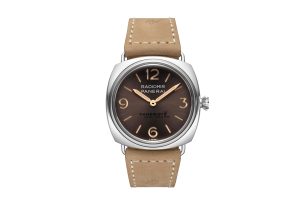
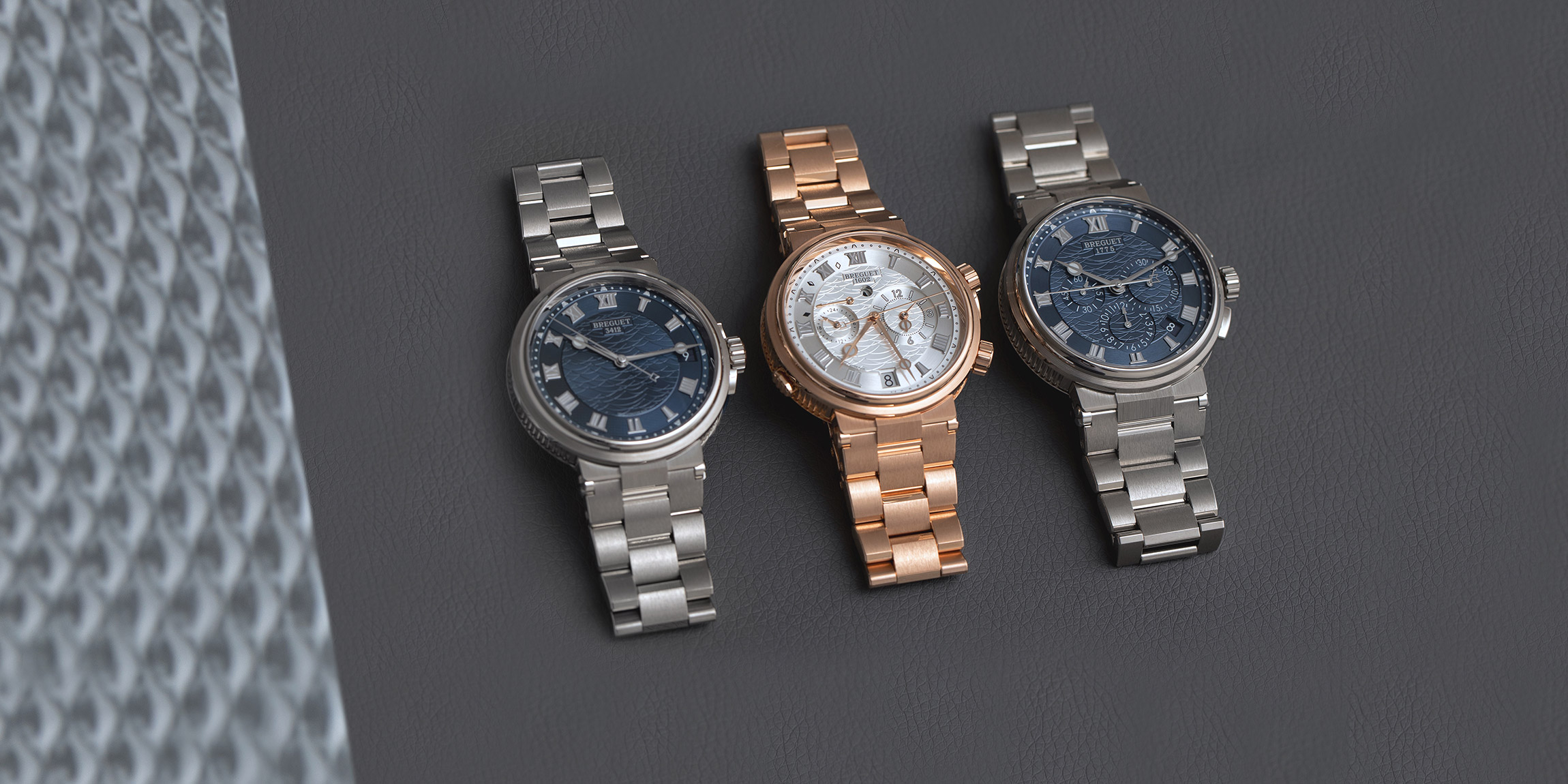
Point of View: Breguet Marine 2020 Bracelet Updates
Breguet is a brand with a vast history, and an equally great heritage on its shoulders. With that in mind, it’s worth asking the question: how has it updated its Marine collection in 2020 to live up to the company’s 18th-century seafaring past?
Any enthusiast who knows a thing or two will know that Breguet’s Marine collection is, in a way, not that historic – after all, it was only introduced in 1990. However, that’s not to say the line doesn’t have a past that the romantics and historians amongst us will appreciate.
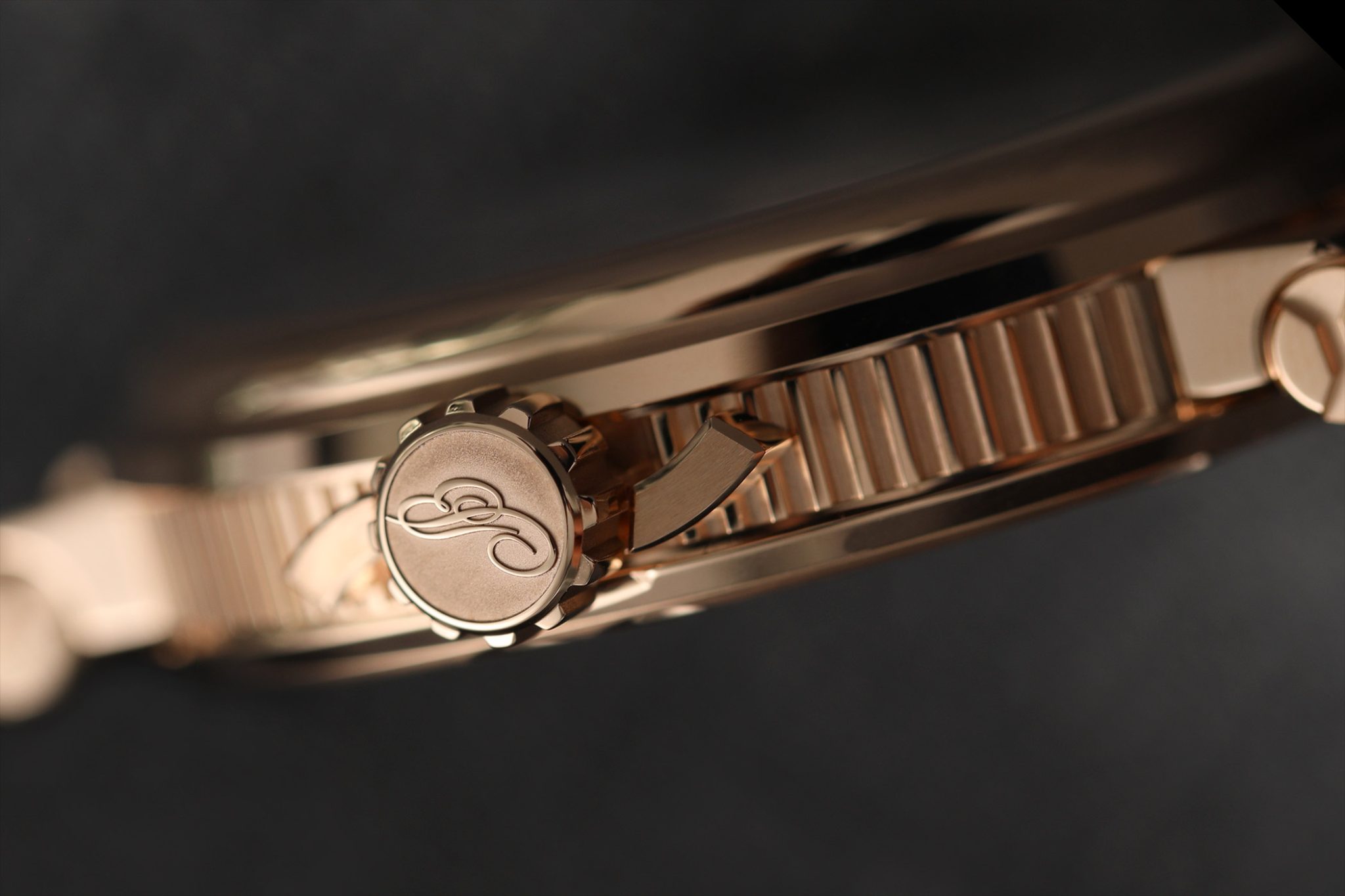
Today, the Marine line is widely known as Breguet’s take on a luxury sports watch, a reputation it has been cultivating since the 90s. However, this was not always the case – Breguet’s seafaring watches have a long history, even if the Marine line does not. With this in mind, it is worth considering how the watches stay true to the brand, as well as the history that inspired their conception.
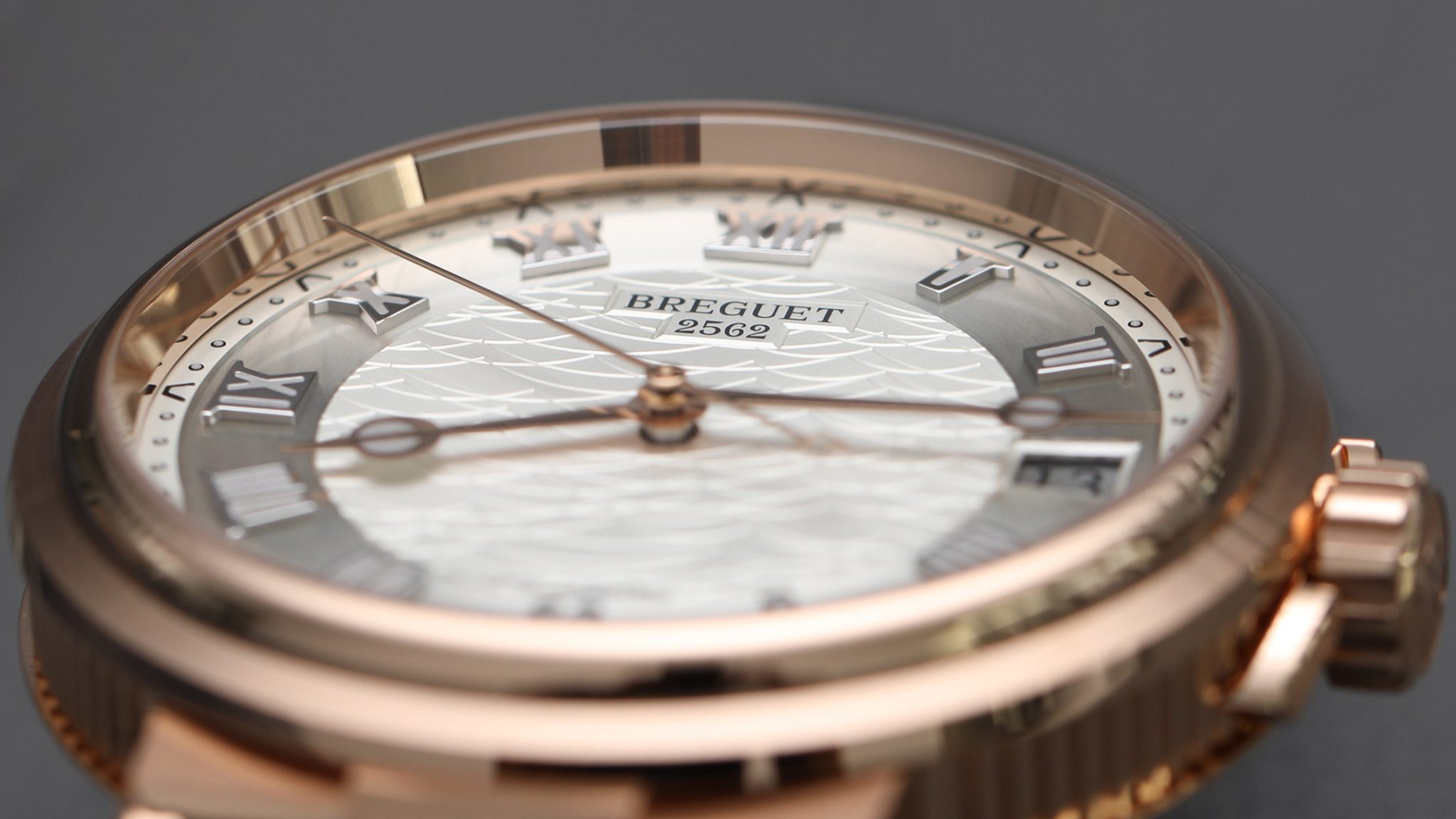
Marine 5517 in rose-gold
How can a 21st-century sports watch satisfy the brand’s purist, traditionalist fans, while gaining new clients in a world that focuses itself increasingly on technology and innovation? In order to find out, this article is going to take you on a journey, right back to where is all began for Abraham-Louis Breguet, as he embarked on his own adventure to create the perfect chronometers.
The Past
In the year 1795, Abraham-Louis Breguet returned to Paris from England, where he had been working for George III. Two years previously, he had fled France, having been marked for execution in Paris due to his friendship with a revolutionary. One year later, in 1796, a 49-year-old Breguet wrote a report stating that he had been working on creating marine chronometers, which were serving to earn him a name in Spain. Interestingly, he had already been working on these specialist watches for about a decade, having started this work as early as the 1780s.

The man himself: Abraham-Louis Breguet
While Breguet is said to have returned from his short stint in England full of inspiration and innovative ideas, it was not until 1815, the year of the formative Vienna Congress, that he was appointed as Horologer to the French Royal Navy. This was the moment that he started to produce chronometers regularly. The groundbreaking watches showcased various escapements, as well as Breguet’s twin-barrel chronometer movement, in which the entire escapement was mounted onto a small interchangeable plate. Again, interestingly, it was first launched in 1818 – over a decade after its conception, demonstrating the difficulty of achieving innovation versus commercial implementation at the time.
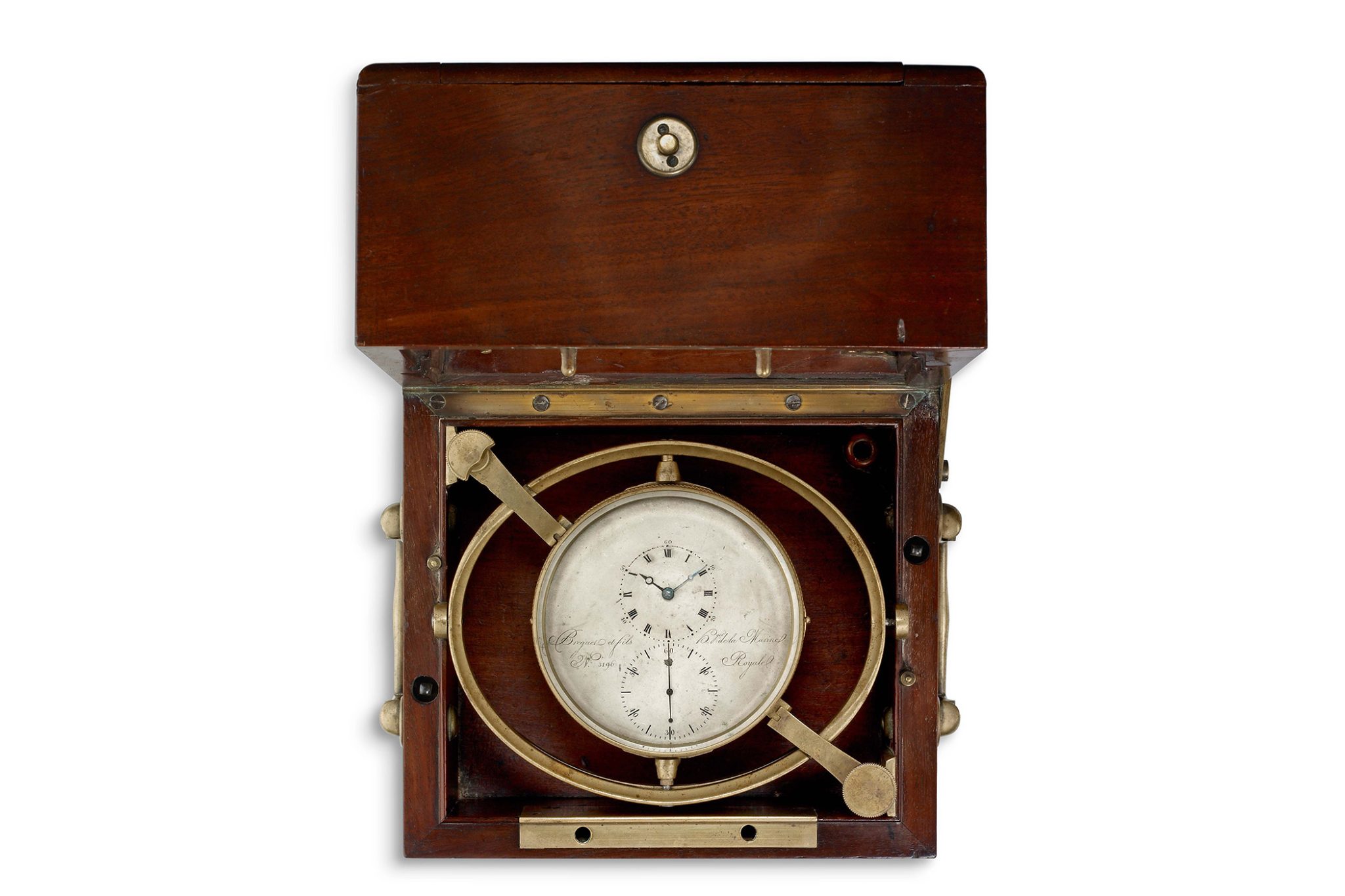
Marine chronometer Nr. 3196
This brings us to Breguet’s unusual way of working. Breguet had a unique and intelligent way of creating chronometers; he would identify prevalent problems within movements, and work to solve these issues. Take the aforementioned twin-barrel chronometer, for example; Breguet had identified that the fusee system not only used the majority of the spring’s output, but also strained the spring, resulting in chain breakage. This led to him creating his double-barrel movement. While requiring more parts, it allowed for thinner springs to be fitted, and did not need to use the entire spring for output, but rather just the middle. This consequently reduced stress on the springs, while providing a more consistent and thus more reliable power supply. If you’re still not impressed, then hear this: such was the quality of his newly invented movements, that all five of Breguet’s marine chronometer watches, which are now kept at the National Maritime Museum in London, still remain with their original springs fully intact.
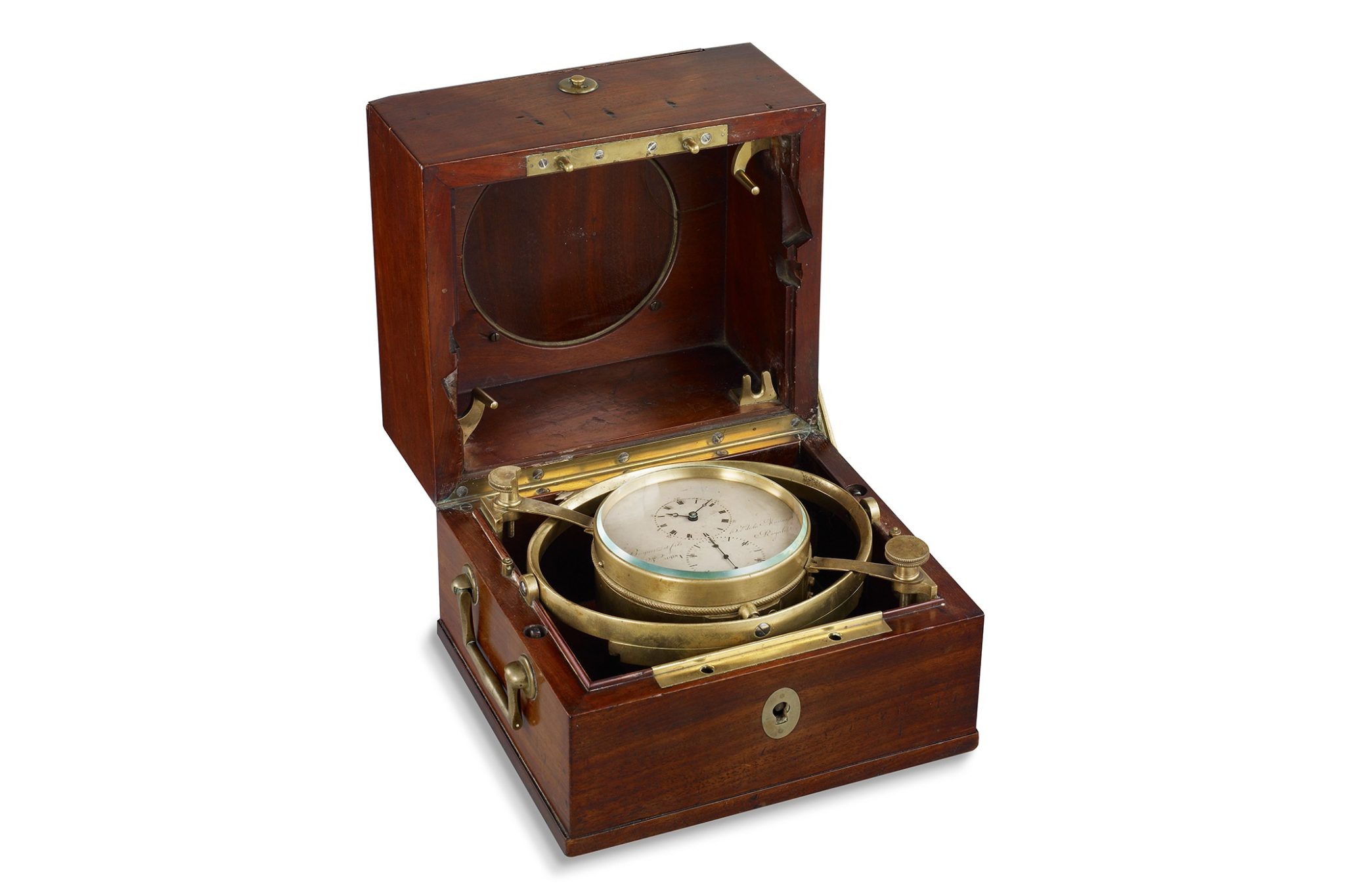
Marine chronometer Nr. 3196
With this problem-solving mentality, Breguet went on to create the parachute shock-protection device on the calibre’s balance cock, which remains an important invention to this day. The device, as many contemporary horology aficionados will also know, prevented the breakage of balance pivots – a common problem at the time.
Of course, Breguet’s chronometer movements – or indeed any watches – back then were not meant for men to wear; rather, wristwatches were simply jewellery for women, meaning there were no bracelets in sight. Therefore, Breguet’s chronometers were carefully kept in wooden boxes, using wood such as walnut, which were accessed using a lock and key. On the top of the wooden box was a round hole matching the size of the chronometer, covered by a sliding lid. This way, naval sailors could easily view the chronometer while keeping the delicate devices safe onboard.
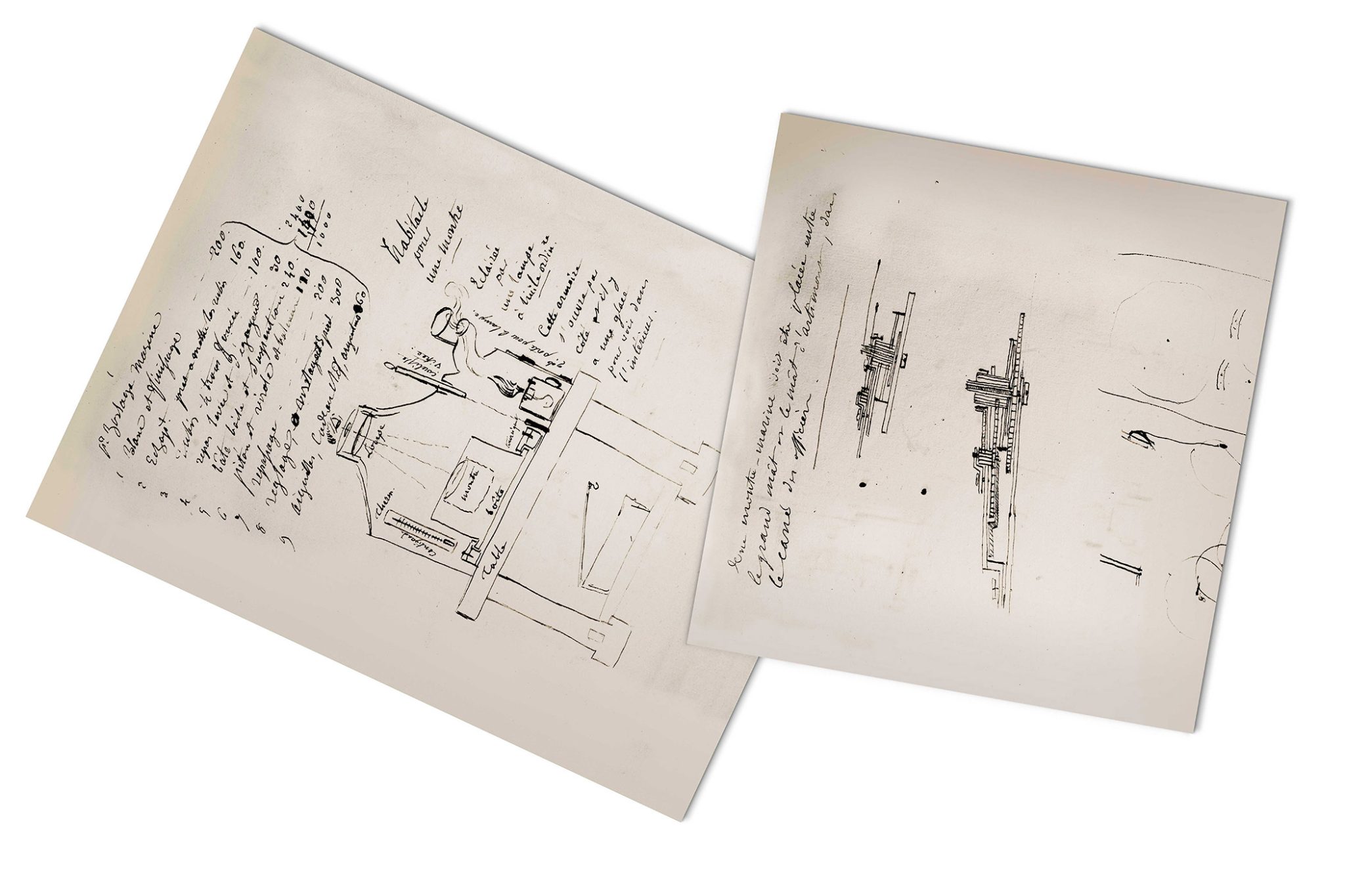
Abraham-Louis Breguet’s sketches and instructions
for the installation of a marine chronometer on a ship
Breguet died eight years after his appointment as the Horloger de la Marine Royal. Upon his death, his son, Antoine-Louis, and grandson, Louis-François-Clement Breguet, continued to supply both the Royal navy and merchant navy with Breguet’s chronometers. They went on to produce a further 133 chronometers to the French navy, up until 1833. At this point, a new company was formed: Breguet, Neveu & Cie. This new business consisted of Antoine Louis, Jonas-Louis Lassier (incidentally Abraham Louis Breguet’s nephew), as well as an accountant named M. Tredos. This new Breguet firm produced over 450 marine chronometers, with its success peaking between the long period of 1818 to 1840. The marine chronometers underwent a change under the direction of Louis-François-Clement Breguet, who worked to create a more economical, efficient way of producing the watches. Therefore, the chronometers became simpler in their design, featuring a less expensive single barrel movement, as opposed to the twin-barrel movements first commandeered by Breguet.
The Path to the Present
After learning about the history behind the watchmaker’s highly successful marine watches, one is left wondering: how did the late 20th-century Breguet manufacture work to utilise its company’s impressive, intriguing heritage when creating its Marine line?
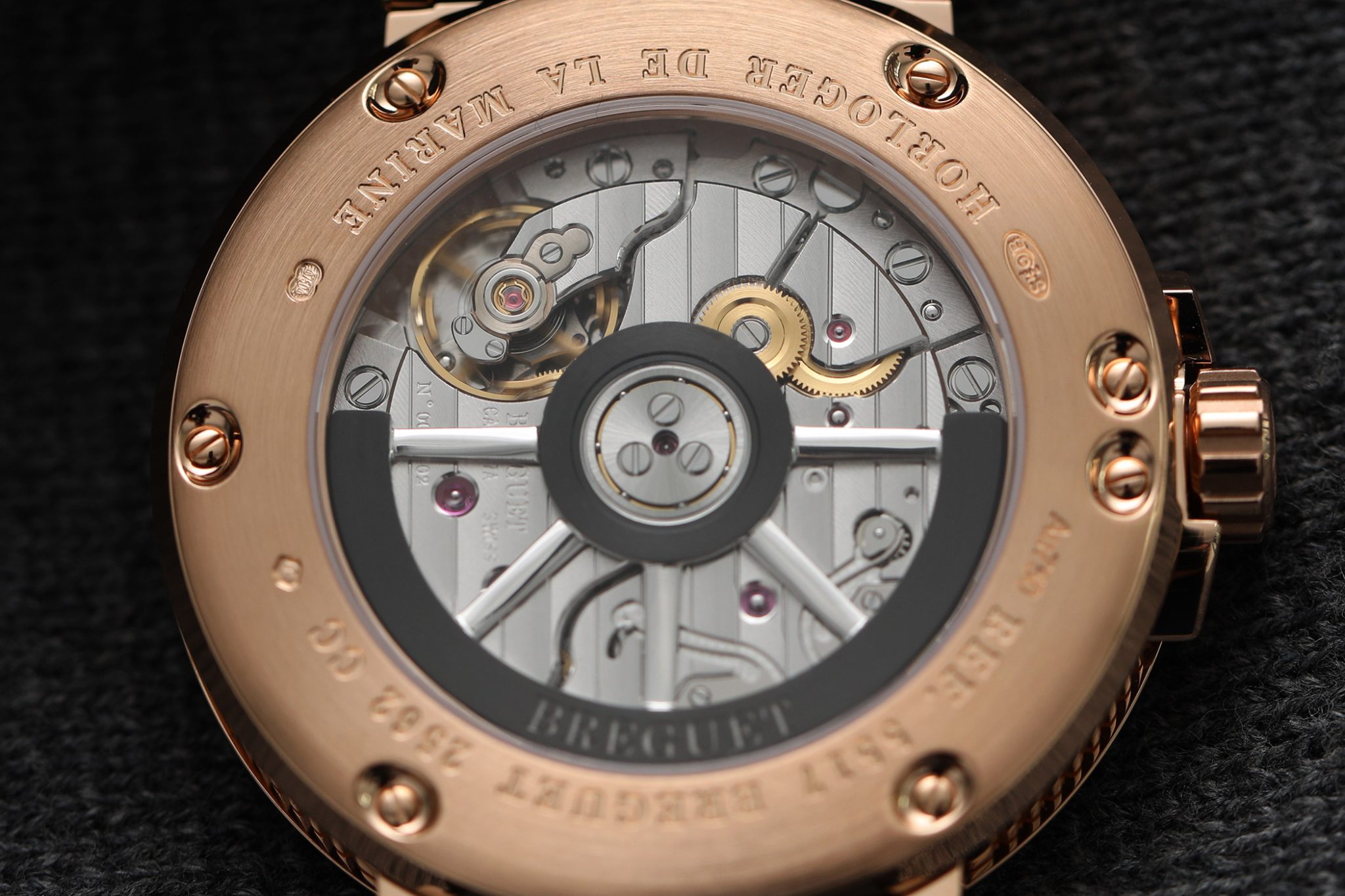
Crucially, the company’s marine history had never truly stopped; the Breguet manufacture spent the 20th century busily supplying the navy with precision instruments such as torpedo-boat clocks, siderometers, pocket watches with twenty-four-hour dials, plus the Type XX chronographs ordered by the navy for its Fleet Air Arm pilots. Therefore, by the end of the century, it made complete sense for the brand to pay tribute to – not to mention commercialise – its remarkable historic ties to naval timekeeping. And so the Marine collection was born.
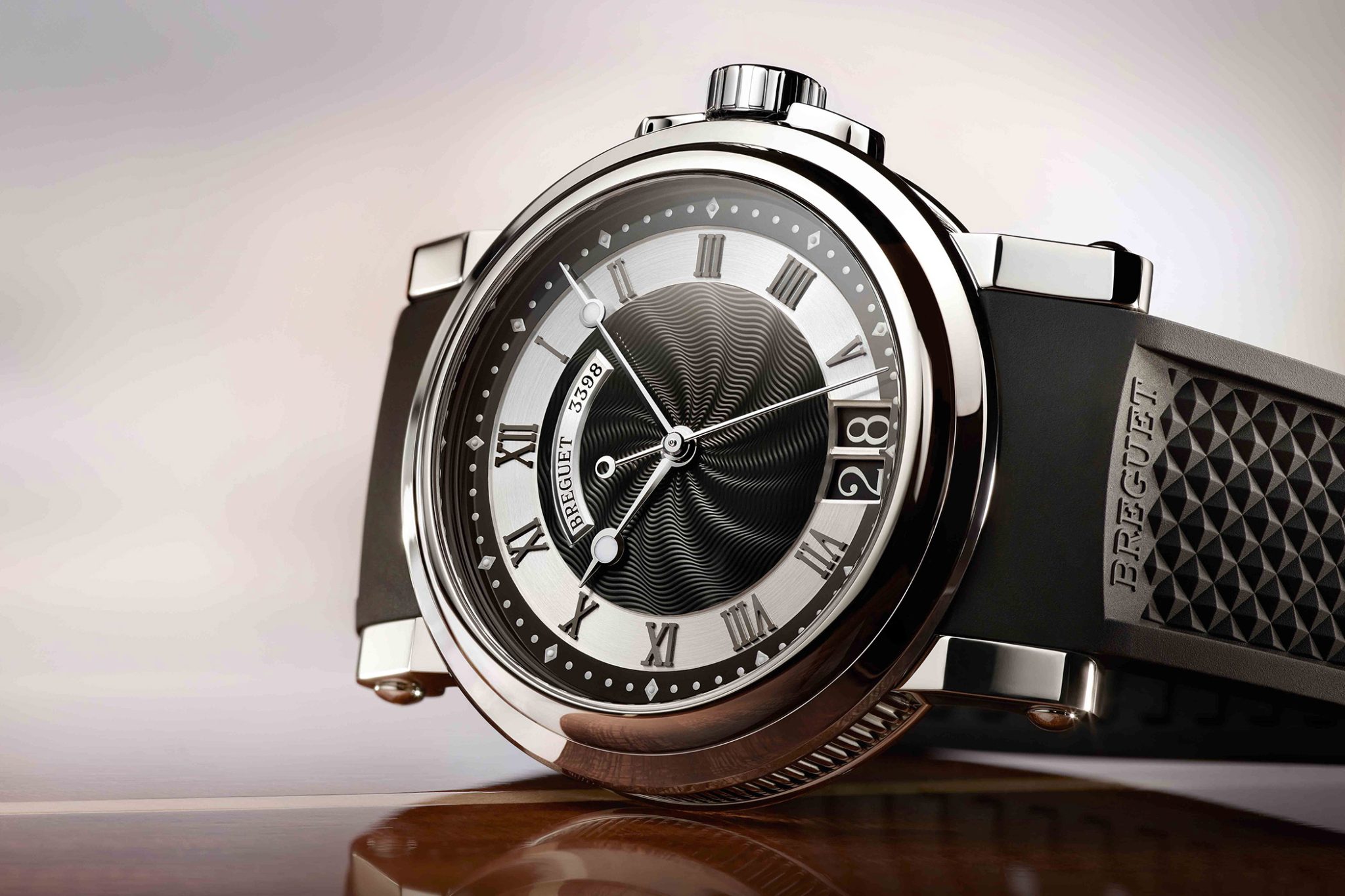
2005: The collection becomes more sporty with the Ref. 5817 Marine Big Date
The company used Jorg Hysek, a celebrated watch designer of the 90s, to create the Marine line, which was at first largely distinguished by its elongated, fluted and domed crown. In 2005, with the introduction of the 5817 Marine model, the line’s design developed to become somewhat more distinctive, featuring a bolder aesthetic as well as more affordable stainless-steel cases and a date window. The watch cases gradually increased in size, featuring slim, elongated lugs alongside elegant leather straps. It was this larger – yet sleeker – design that pushed the Marine watches to become the brand’s best-sellers.

Marine Chronograph 5827, Marine GMT 5857, Marine Royale 5847
The next big step for the increasingly popular line was a revamp that took place back in 2017, when Breguet revealed its Marine Équation Marchante 5887 with a slate-grey dial, calculatedly pushing the Marine collection further into the limelight. The watch elegantly wove together parts of Breguet’s history, featuring an equation of time complication in tribute to King Louis XVIII’s appointment of Breguet as Horologer de la Marine Royale. At this point, the Marine models began to feature the unmistakable wave guilloche dial centre, evoking the line’s marine inspiration.
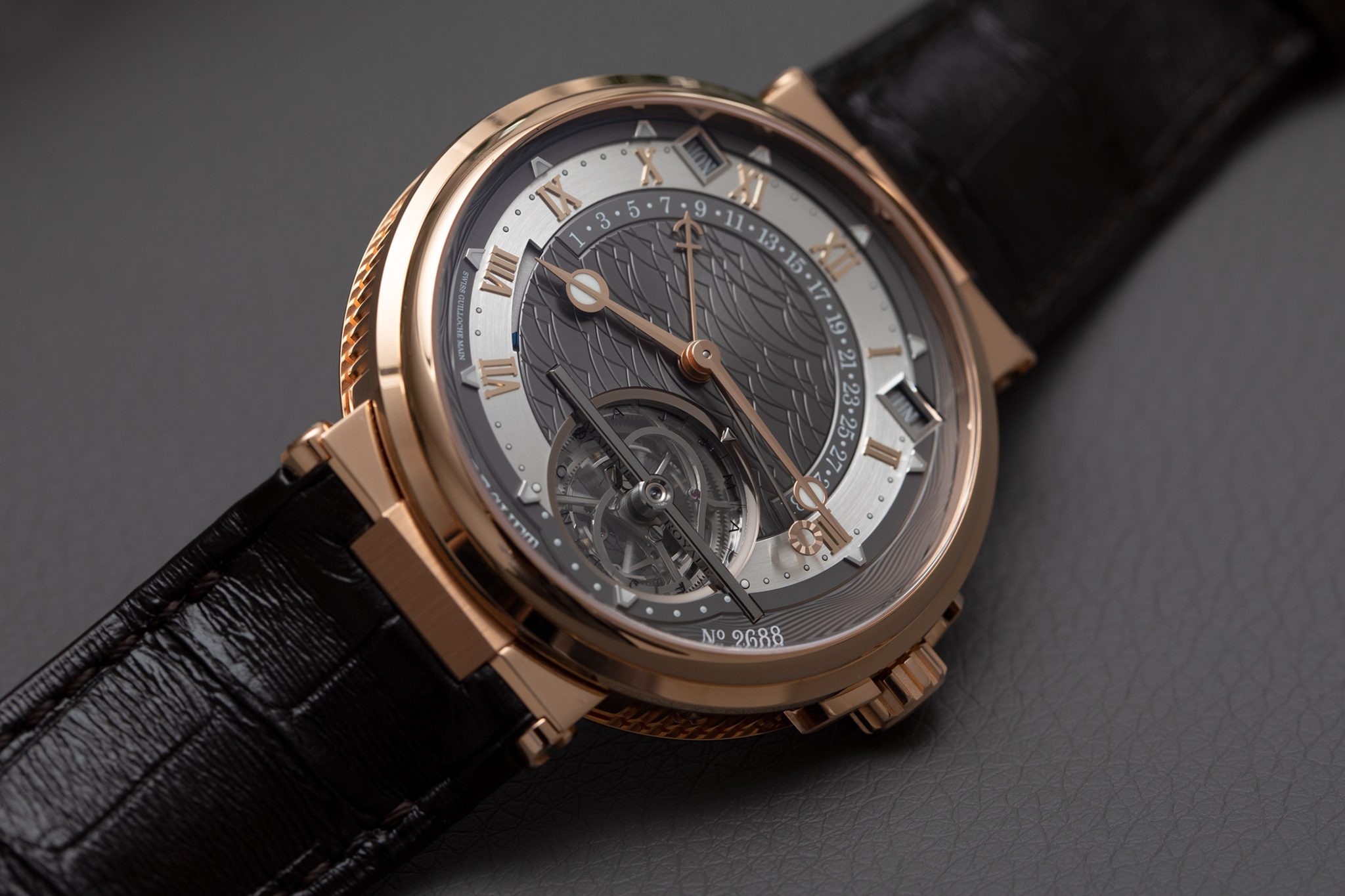
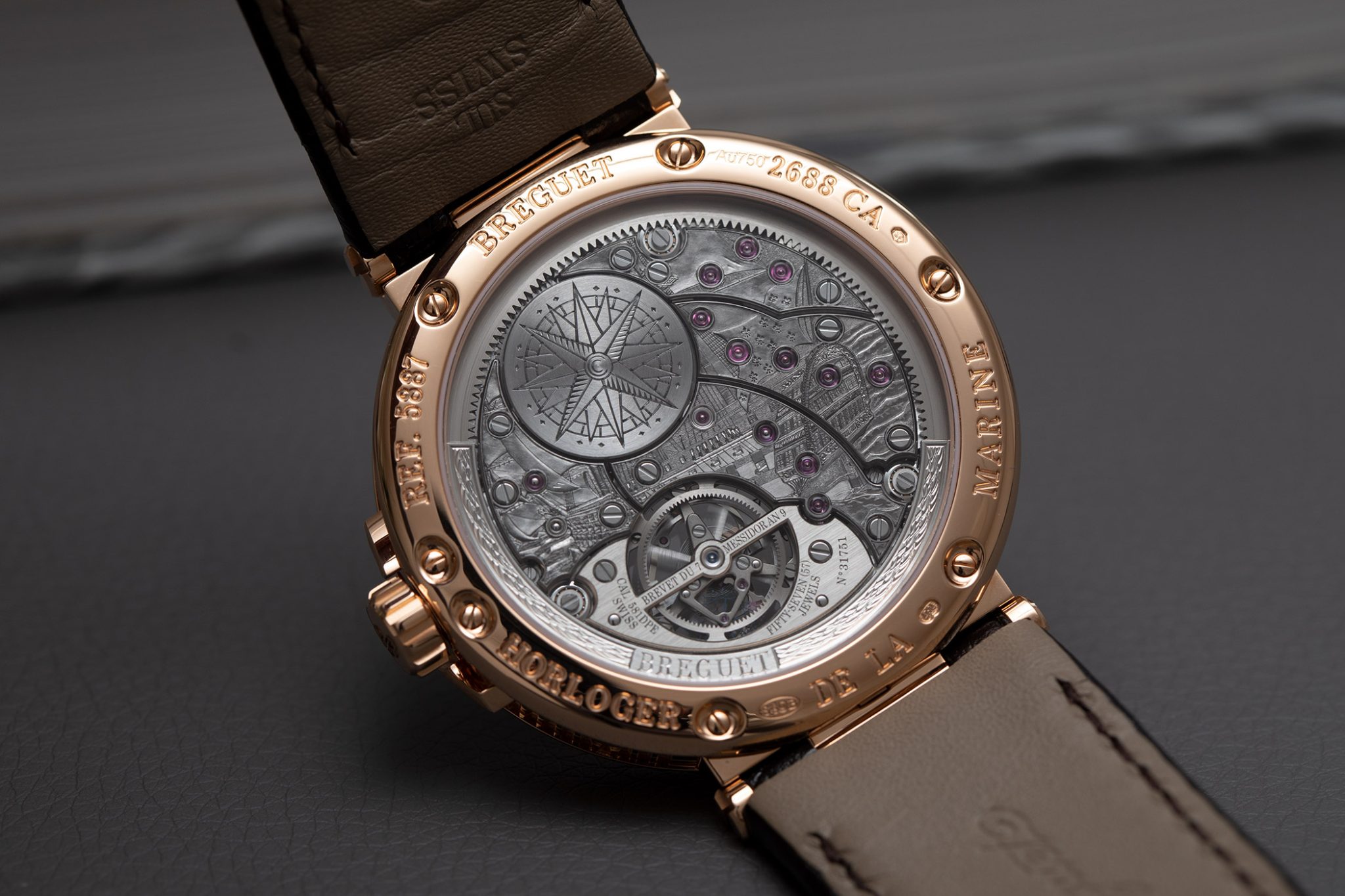
That brings us to 2018, which was also a year of change – the Marine watches established themselves as true sports pieces, introducing titanium (alongside white-gold and rose-gold) cases for the first time. The Breguet Marine Chronographe 5527 and Marine 5517 models were launched that year, along with a redesigned case (42.3 mm for the 5527 and 40 mm for the 5517). However, there was a catch; the titanium models were only available with a rubber or leather strap – a dealbreaker for some.
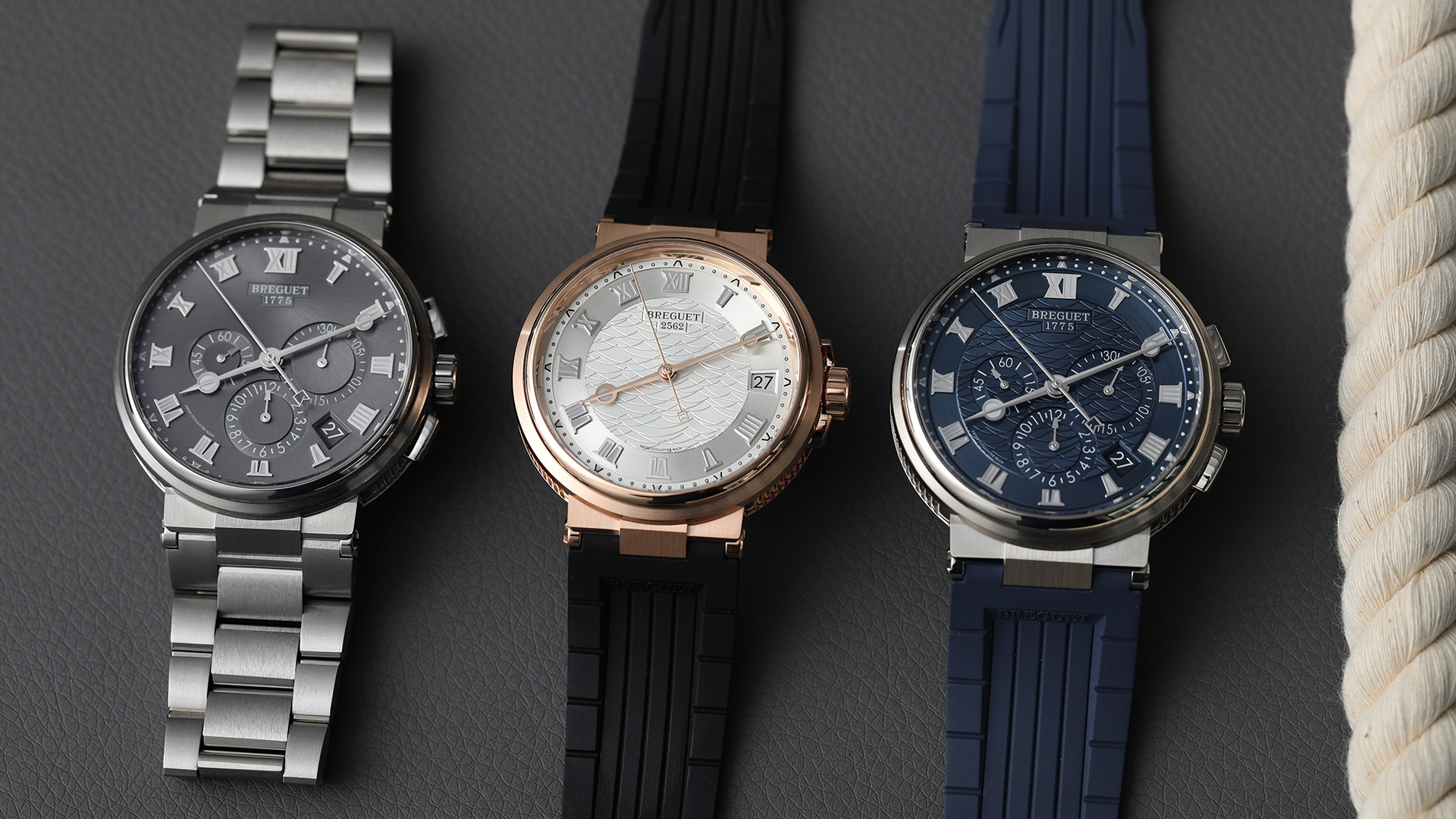
Different straps, different aesthetics
In 2019, the brand finally introduced the titanium bracelets fans of the 5517, 5527 (and the Alarme Musicale 5547) had been hoping for, in the form of integrated bracelets with proprietary lugs. Incidentally, the Marine Alarme Musicale 5547 is also worth a quick mention, due to its impressive mechanical features. The integrated, self-winding alarm function of the watch has the ability to alert its wearer to the date, provide a wake-up call, or remind its owner of an imminent event. When striking, a ship’s bell appears at 12 o’clock. Furthermore, the striking mechanism has a power reserve indicator, divided into three parts (full, half-full, empty) between 9 and 12 o’clock. The watch also offers a second time-zone. In this sense, the Marine Alarme Musicale 5547 showcases its adventurous, sea-faring spirit more overtly than its counterparts.
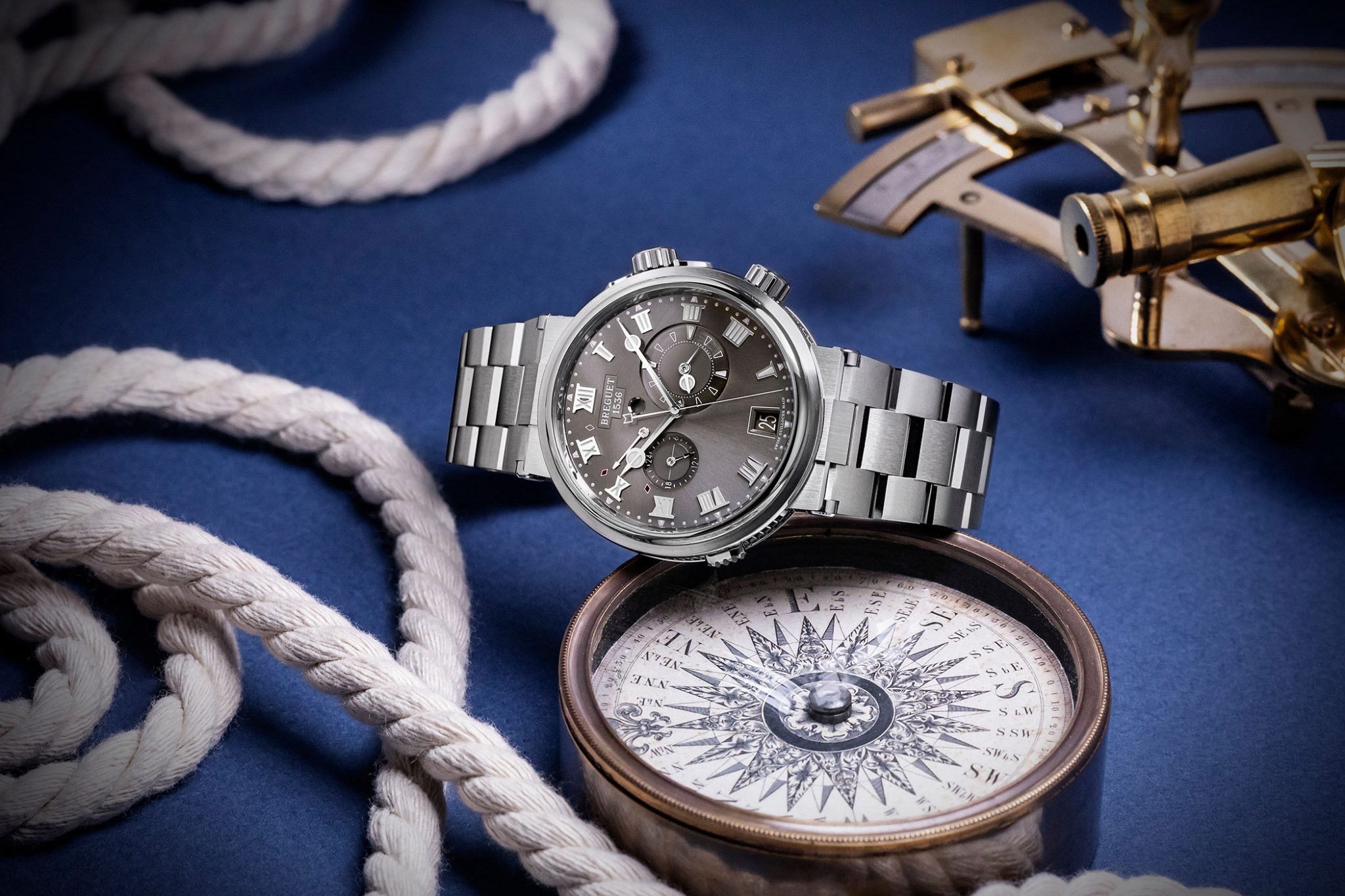
Marine Alarme Musicale 5547
The choice of titanium had a poignant meaning in light of the line’s maritime inspiration; not only is the material light and robust, but it is also resistant to corrosion and salty sea air – perfect for a diver’s watch. However, the white-gold and rose-gold models remained without a bracelet.
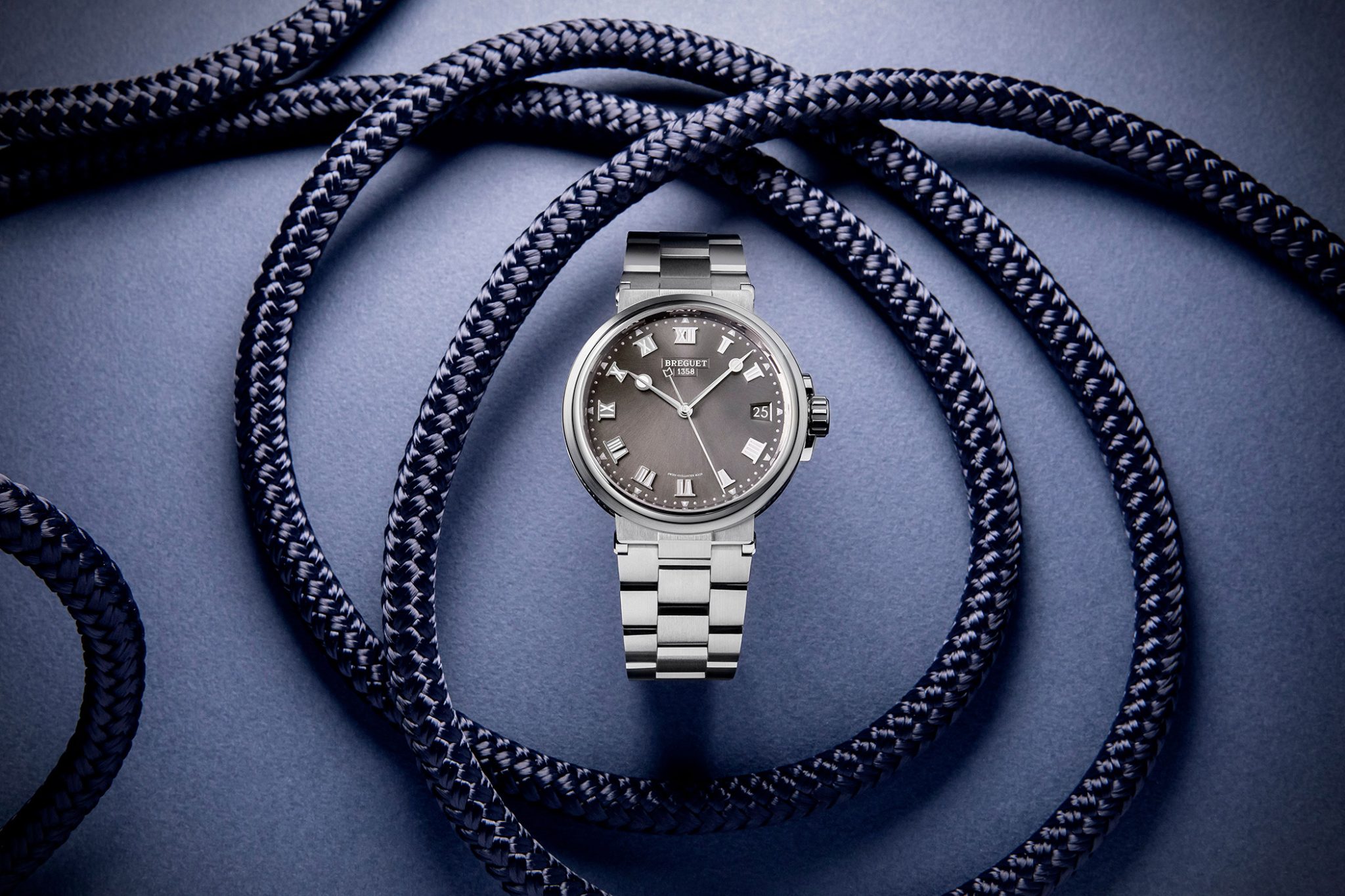
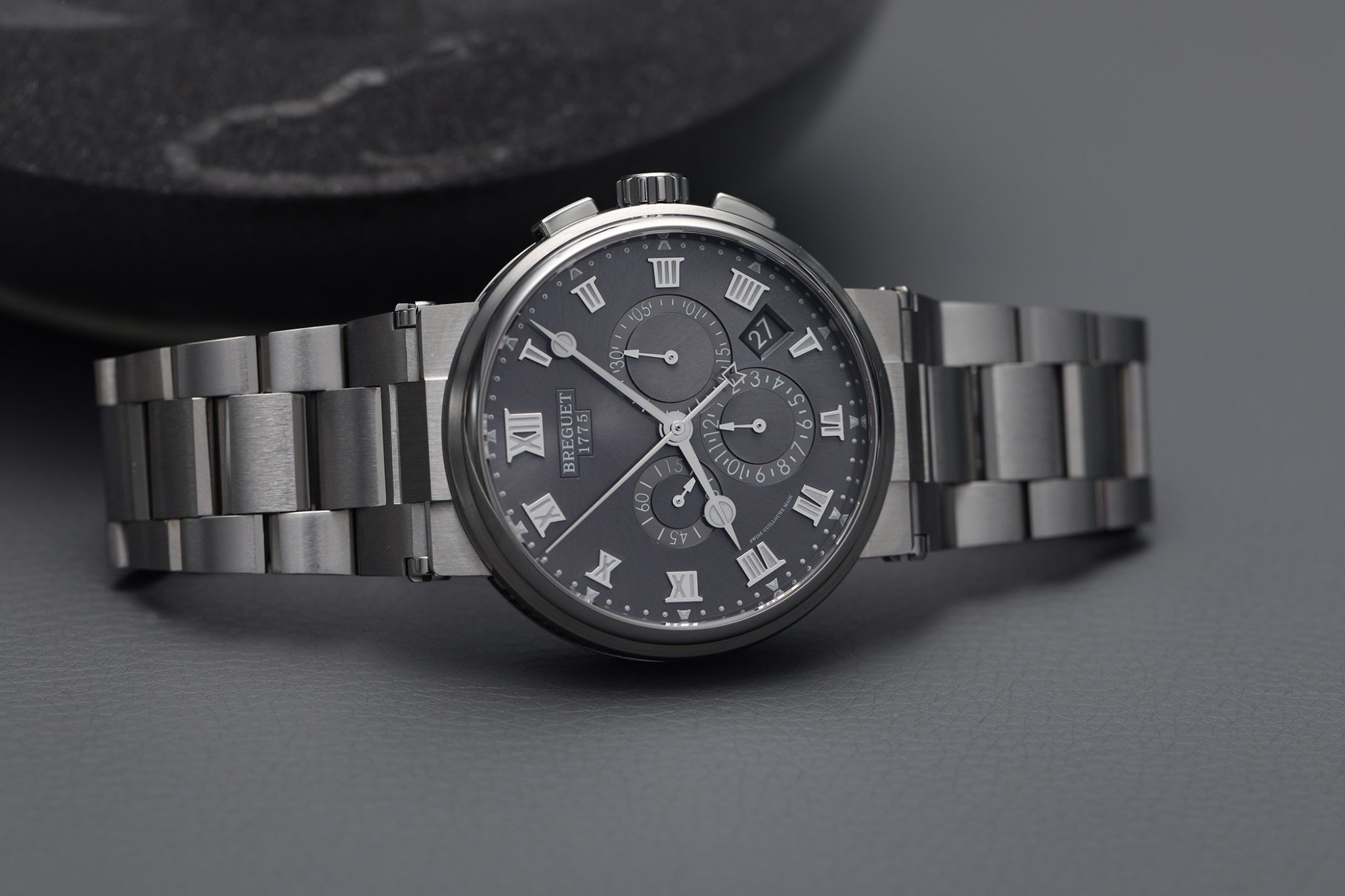
The non-titanium Marine Chronographe 5527 models continued to be presented on either a black rubber or blue (for white-gold) or brown (for rose-gold) alligator leather strap. Meanwhile, all of the new Marine 5517 models were presented on a blue leather or rubber strap (white-gold), or black rubber or brown strap (rose-gold). The non-titanium versions of the Marine Alarme Musicale 5547 also remained only available on a leather or rubber strap. If you’re interested in further discovering the ins-and-outs of the watches, you can read our article on last year’s 5517 and 5527 models, as well as the Marine Dame 9517.
Going Full Circle: Bracelets All Round
This year, 2020, all of the Marine models are finally available not only with titanium bracelets, but also 18-carat white-gold or rose-gold integrated bracelets. The 18-carat rose-gold material is reserved for watches featuring a silver dial, while white-gold is used for the Marine models with a blue dial.
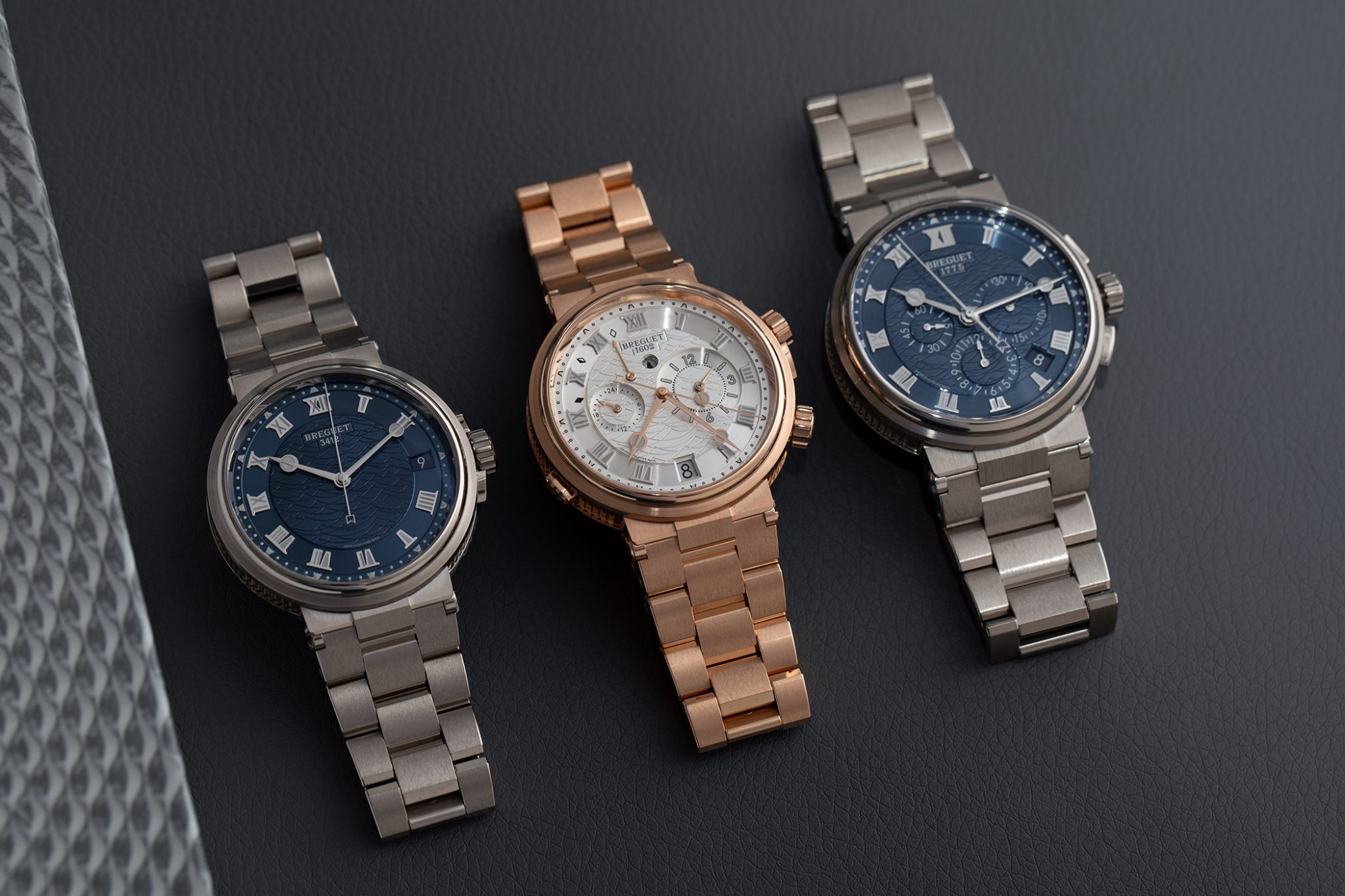
One might question why Breguet decided to add two more integrated bracelet materials in 2020. Not only is the line, as explained, now significantly sportier than upon its initial conception, but it also appeals to its marine heritage. After all, Marine watches pay tribute to a maritime history, and Breguet makes sure that the models – bracelets included – acknowledge this. With this in mind, let’s take a look at Breguet’s Marine bracelets.
The Bracelet Design
Starting from the case and heading outwards: the lugs of the integrated bracelets exude a nautical feel, having been sculpted to accentuate the roundness of the typically fluted cases – evoking a porthole, perhaps. Meanwhile, the three-link bracelets themselves are, like the watches, pretty hardy, but nevertheless elegant. The links of the bracelets alternate between delicately polished and glossy facets – no easy feat for the watchmakers at Breguet, and a reassuring reminder of the company’s craftsmanship. Meanwhile, the links themselves are secured with the help of surprisingly strong, large screws on the inside of the bracelet. Finally, the bracelets are operated via a concealed triple-folding clasp.

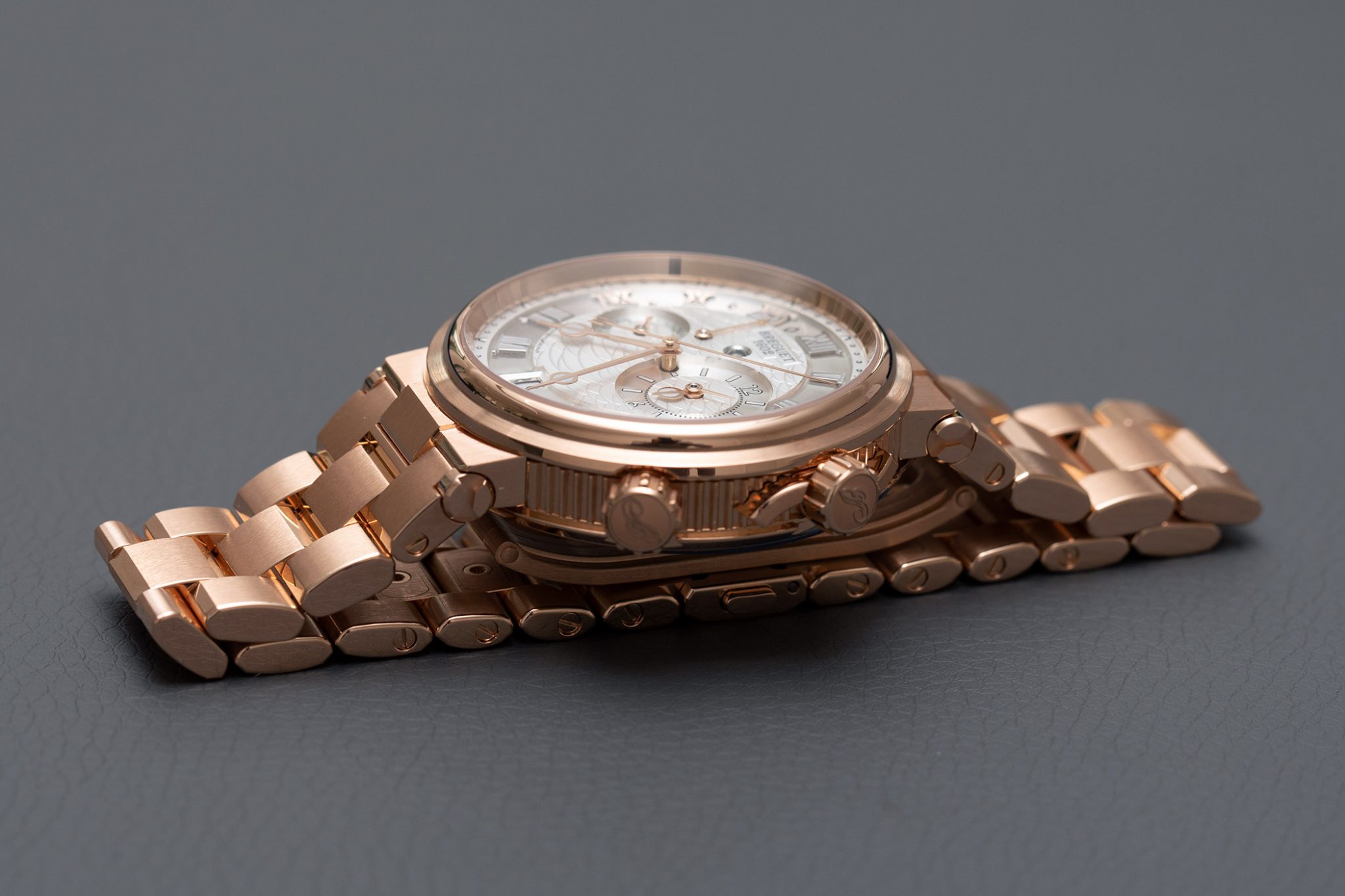
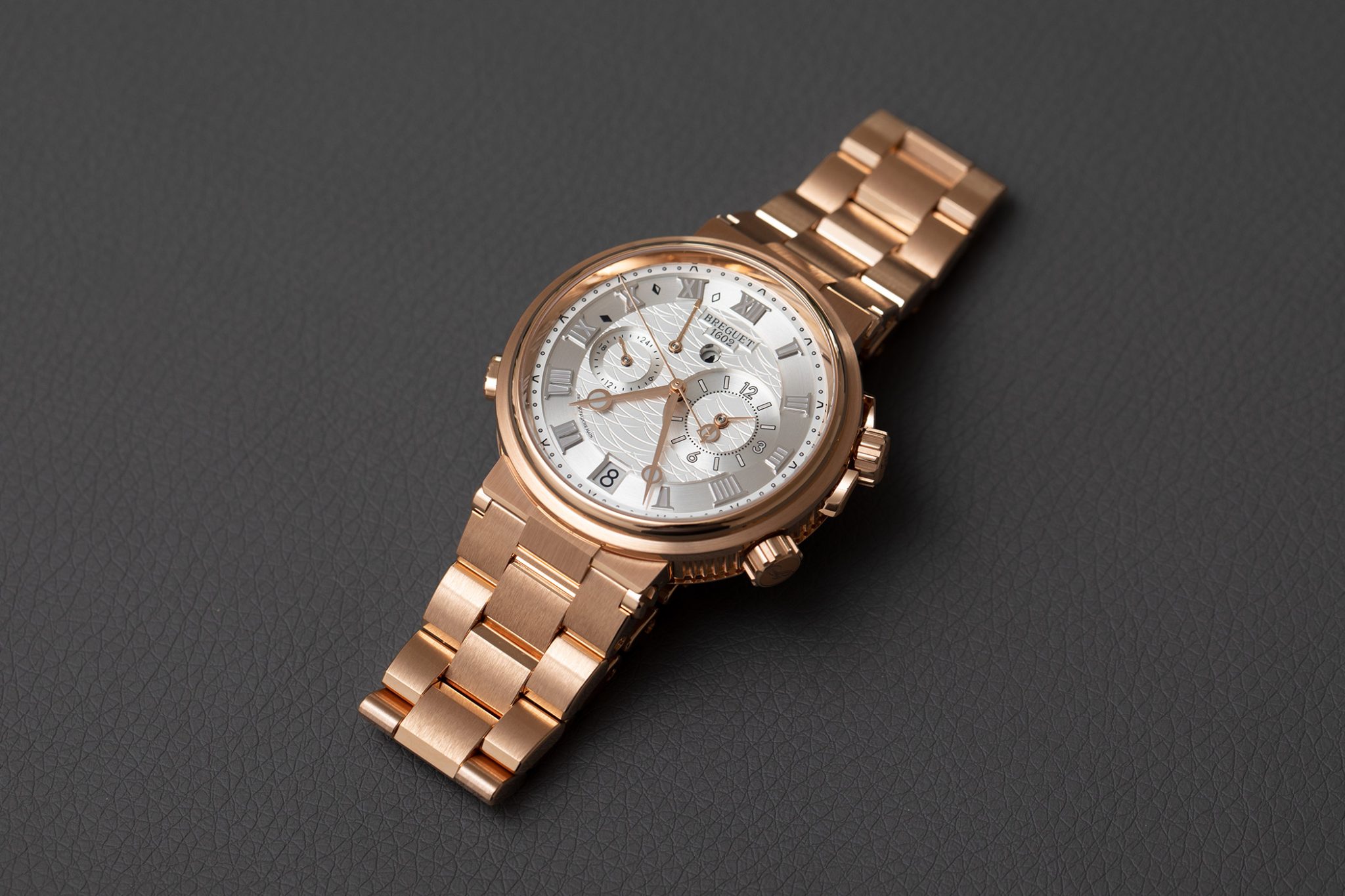
Marine Alarme Musicale 5547 in rose-gold (Ref. 5547BR/12/RZ0)
It’s also worth taking a look at how the three materials vary. Starting with the precious metals, the gold versions of the 5517 and 5527 definitely make for a statement piece. However, as one might expect, the bracelets, combined with the matching case and gold dials, make the pieces feel noticeably heavy on the wrist. Whether or not this is a good thing is really a matter of taste. By contrast, the titanium versions not only look, but also feel both agile and slight, thanks to the lightness of the alloy.
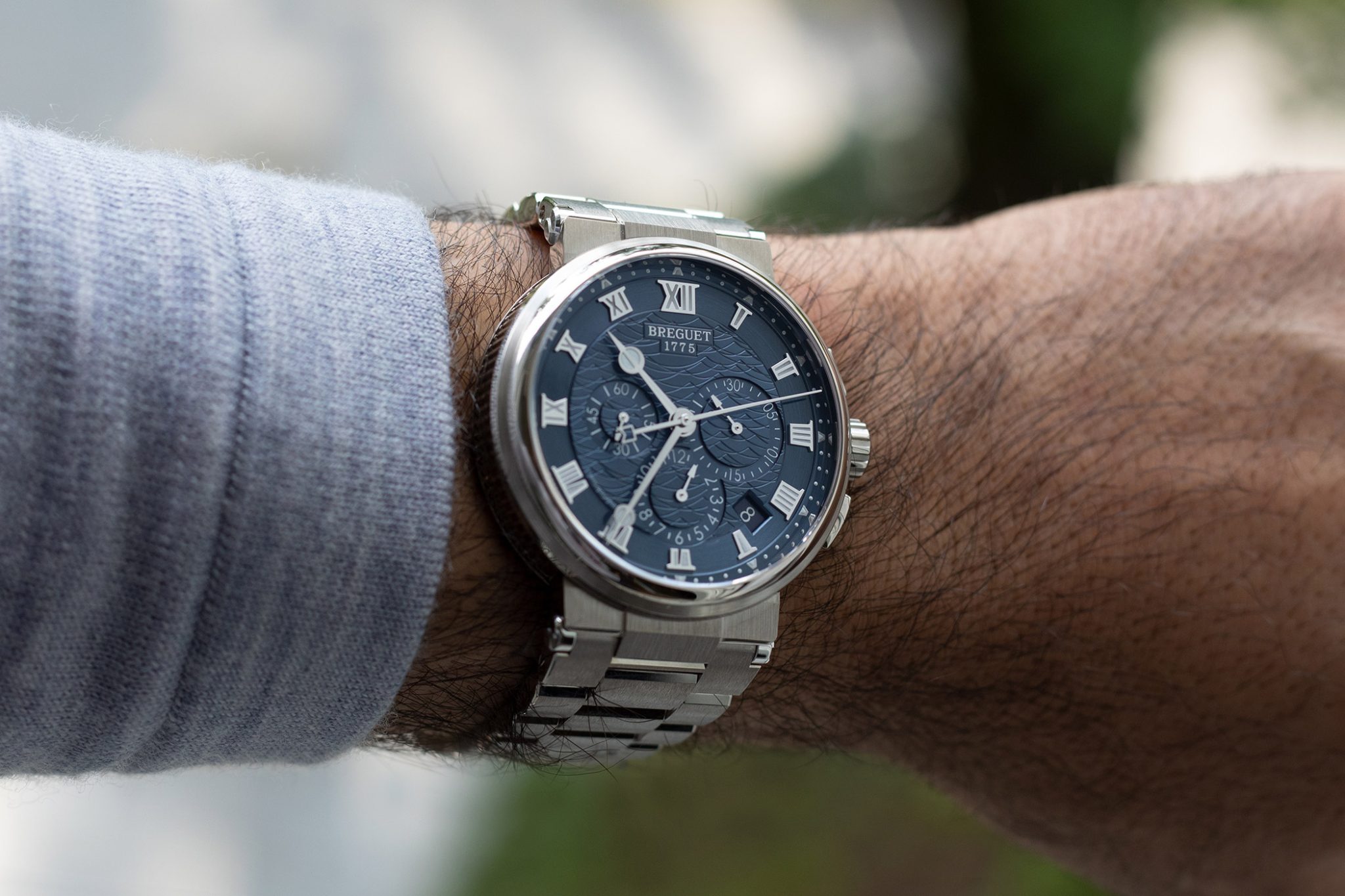
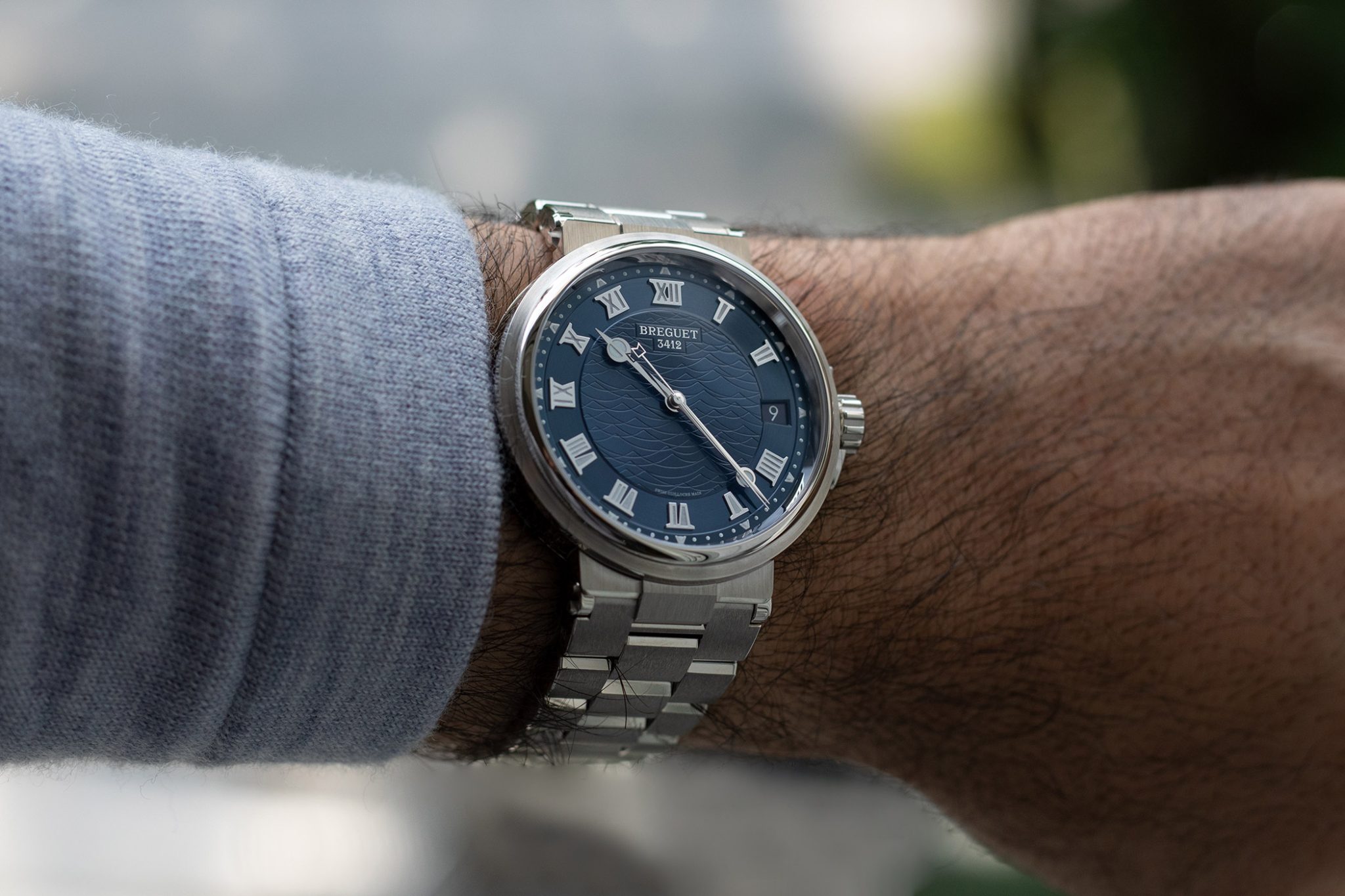
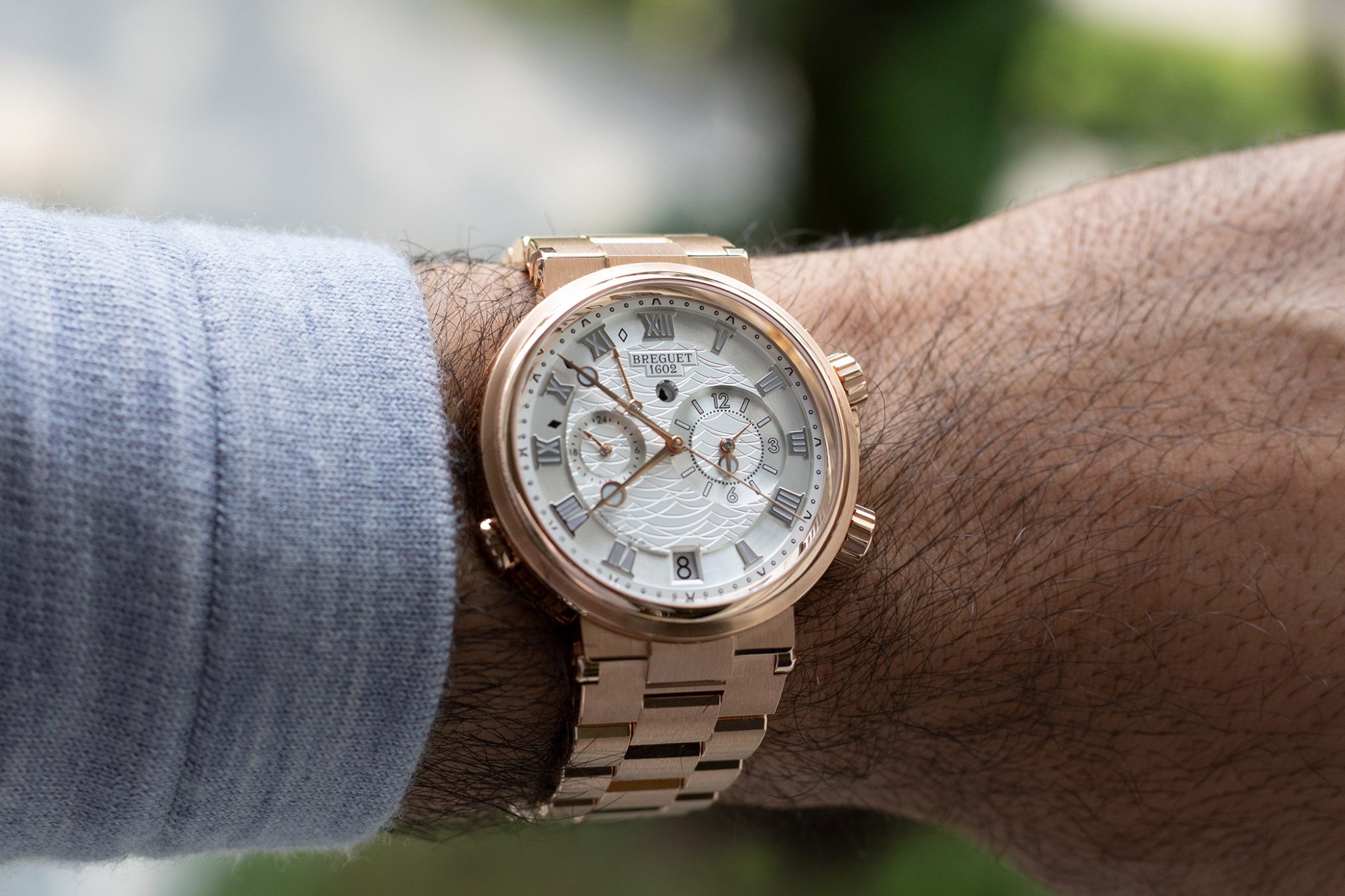
Ref. 5547BR/12/RZ0 on the wrist
At the end of the day, the inclusion of precious metals are never going to be for everyone, but they do demonstrate how a strap or bracelet can transform not only the aesthetic, but also the feel, of a watch. The titanium, thanks to its light and sea-faring properties, is undoubtedly still the winner in my opinion. However, the heavy precious metal bracelets do emanate a sense of Breguet splendour.
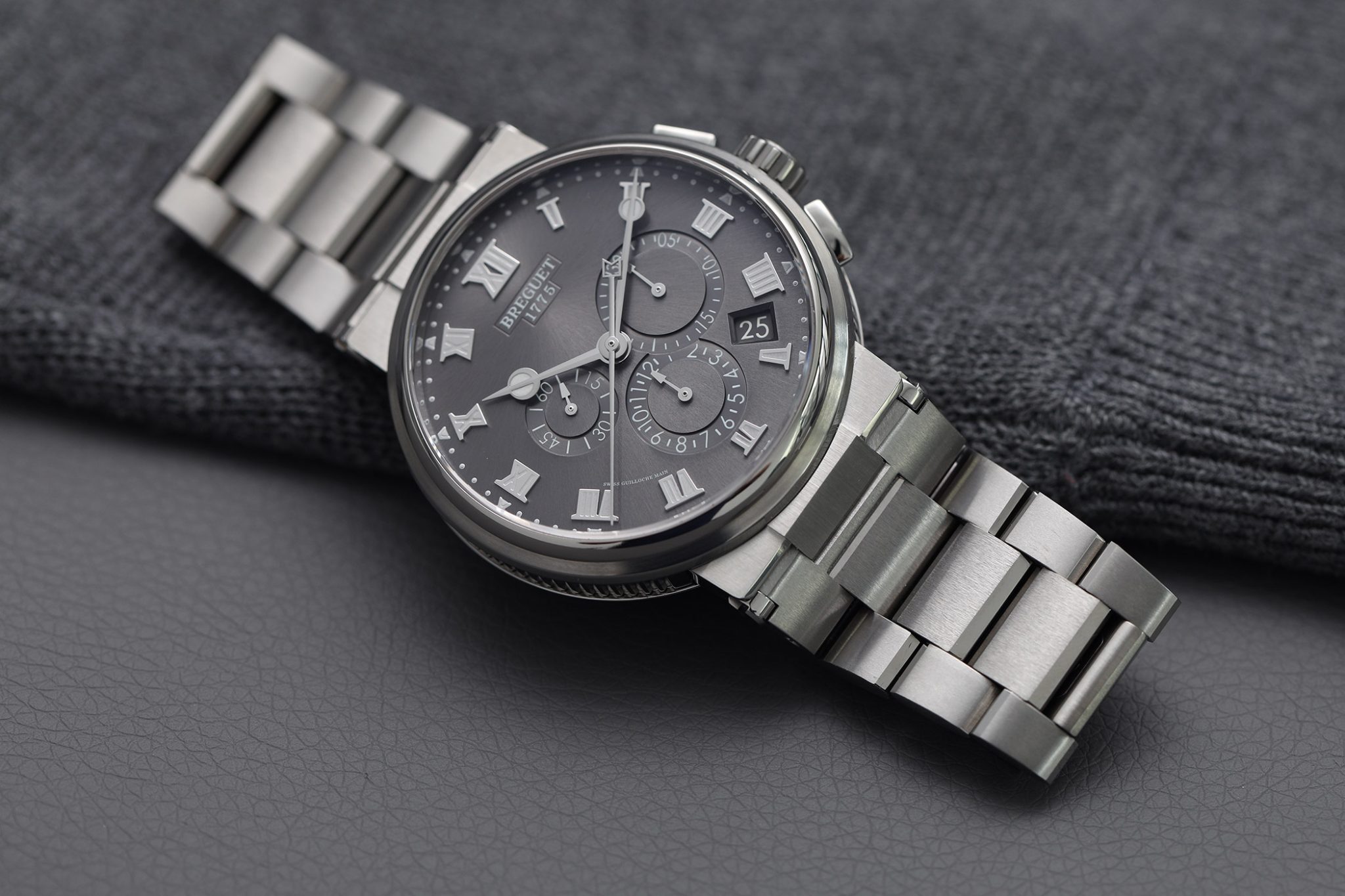
Marine Chronographe 5527, titanium model
Finally, it is interesting to compare the current prices of the bracelet and rubber/leather strap versions, starting with the Marine 5517. The 18-carat rose gold version with a silvered gold dial costs 26,870 euros with a leather or rubber strap – or 46,130 euros with the bracelet. The same applies to the white-gold versions with a blue-coloured gold dial. By contrast, the titanium versions with a sunburst slate grey dial in gold cost 16,270 euros with a rubber or leather strap – or 18,680 euros with the titanium bracelet.
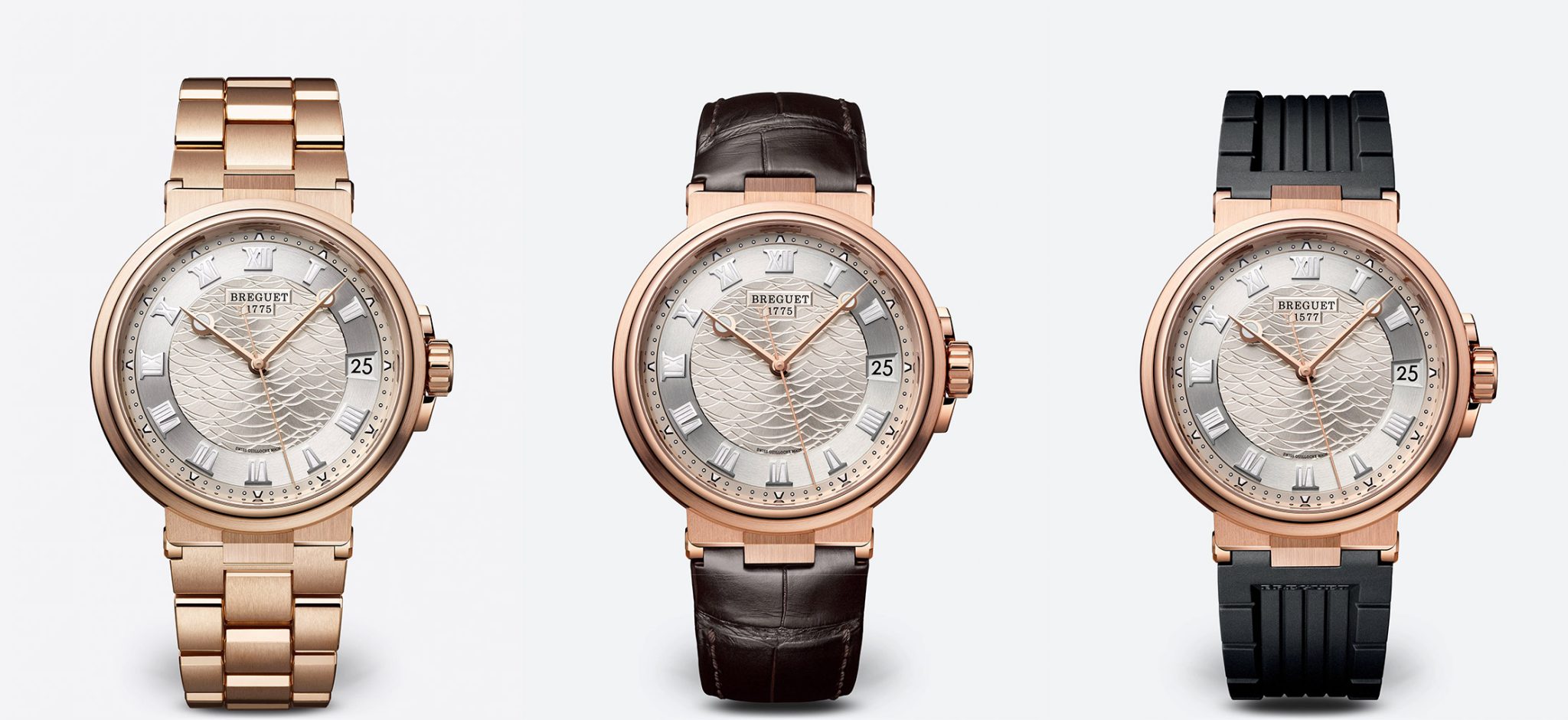
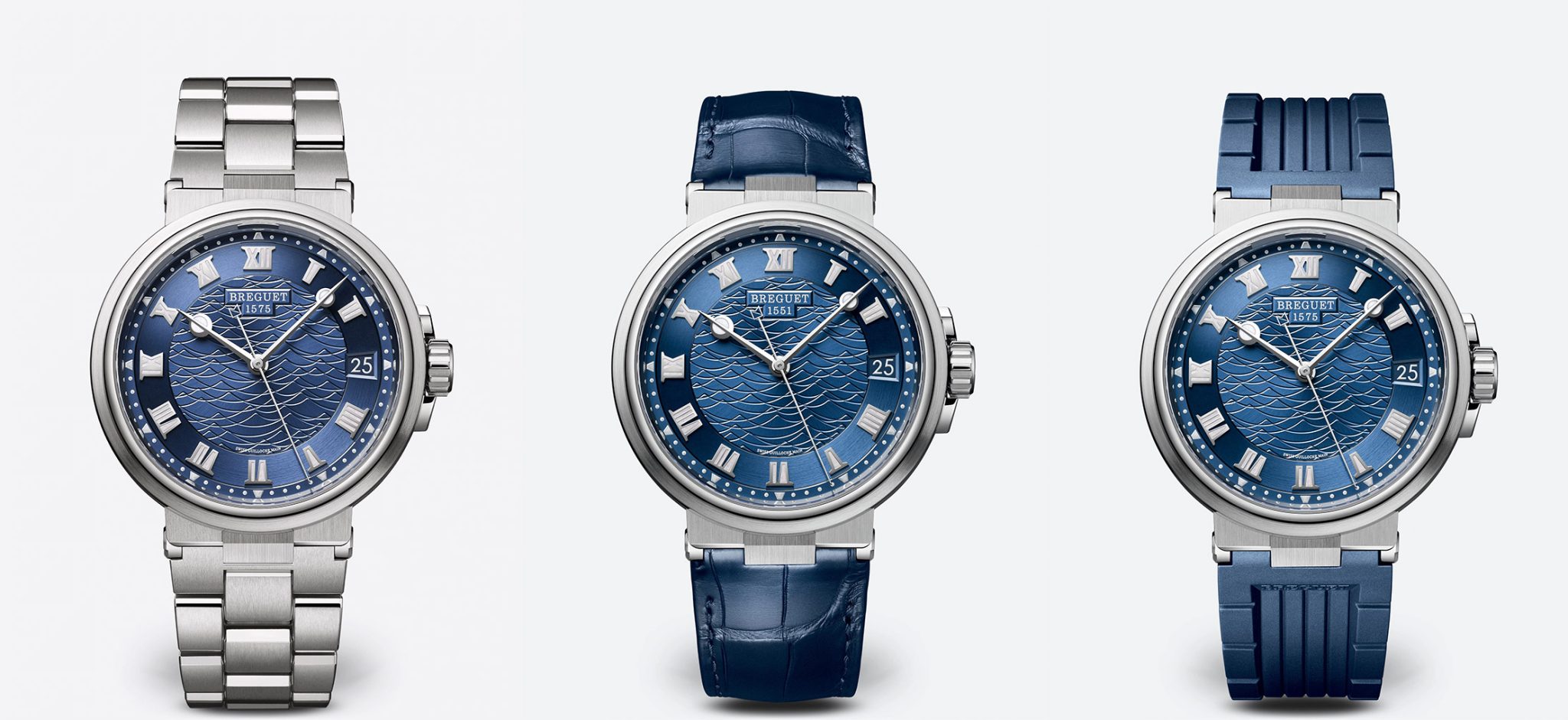
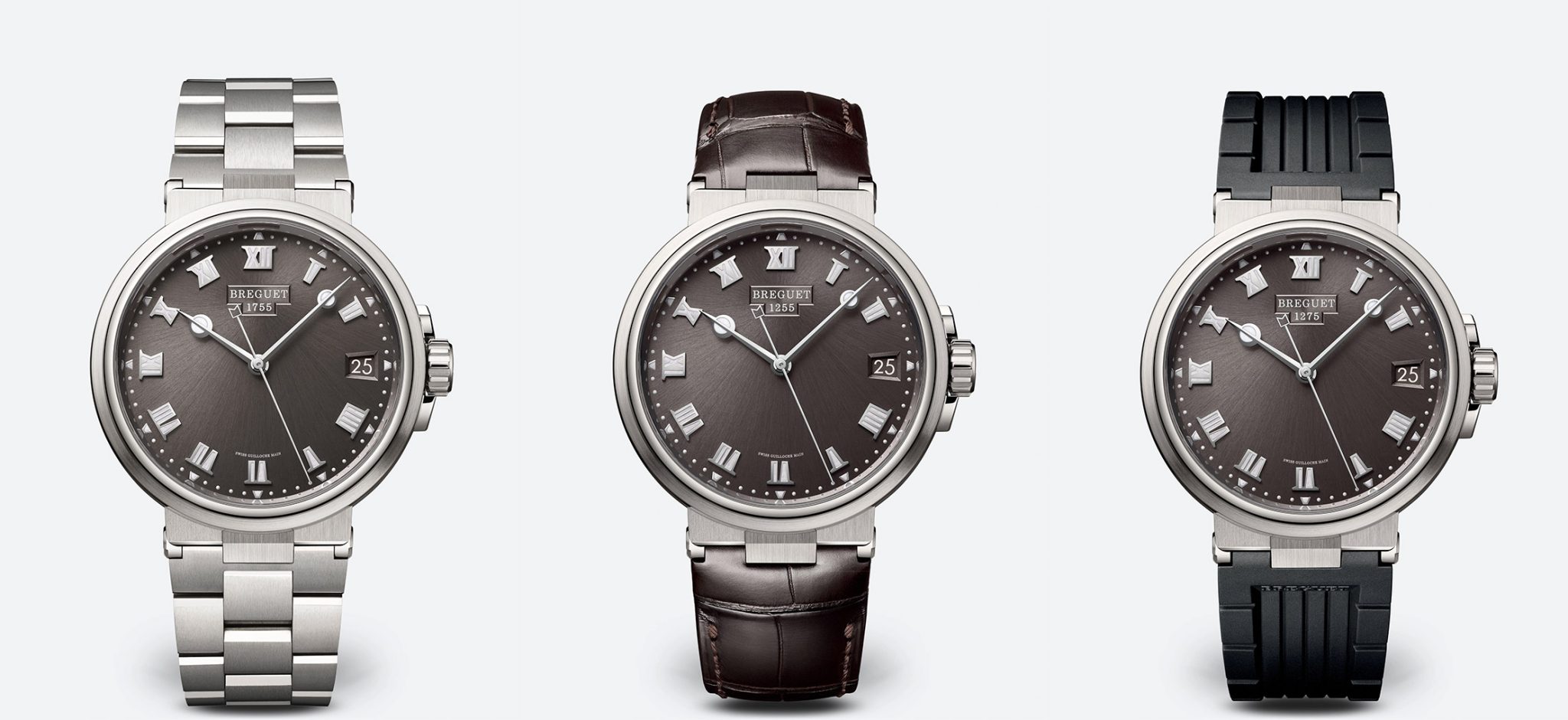
The bracelet/strap options transform the Marine 5517 titanium models
Meanwhile, the Marine Chronographe 5527 in 18-carat rose gold with a silvered gold dial costs 31,780 euros with a leather or rubber strap – or 52,970 euros with the matching bracelet. Again, the same prices apply to the white-gold versions with a blue-coloured gold dial. By contrast, the titanium versions with a sunburst slate grey dial in gold cost 20,220 euros with a rubber or leather strap – or 22,630 euros with the bracelet.
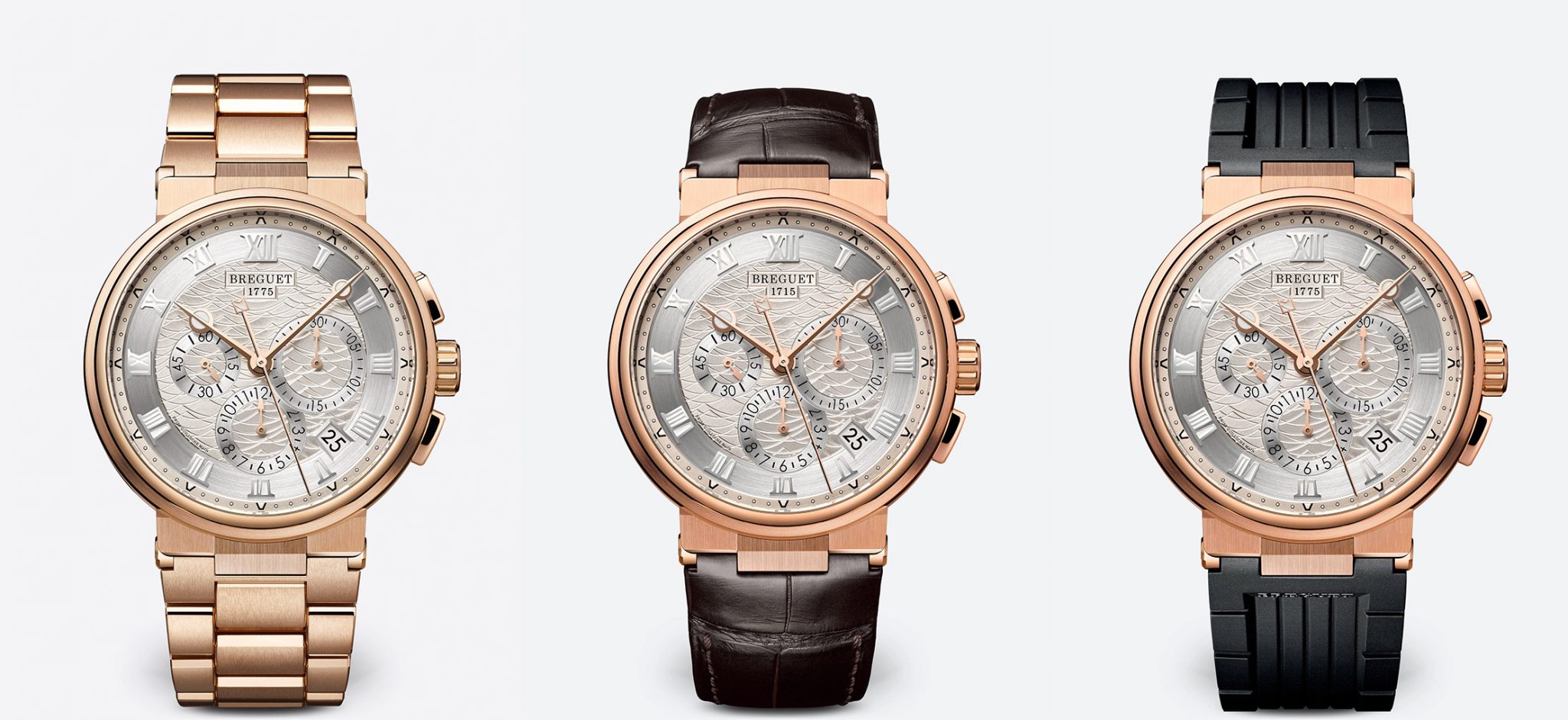
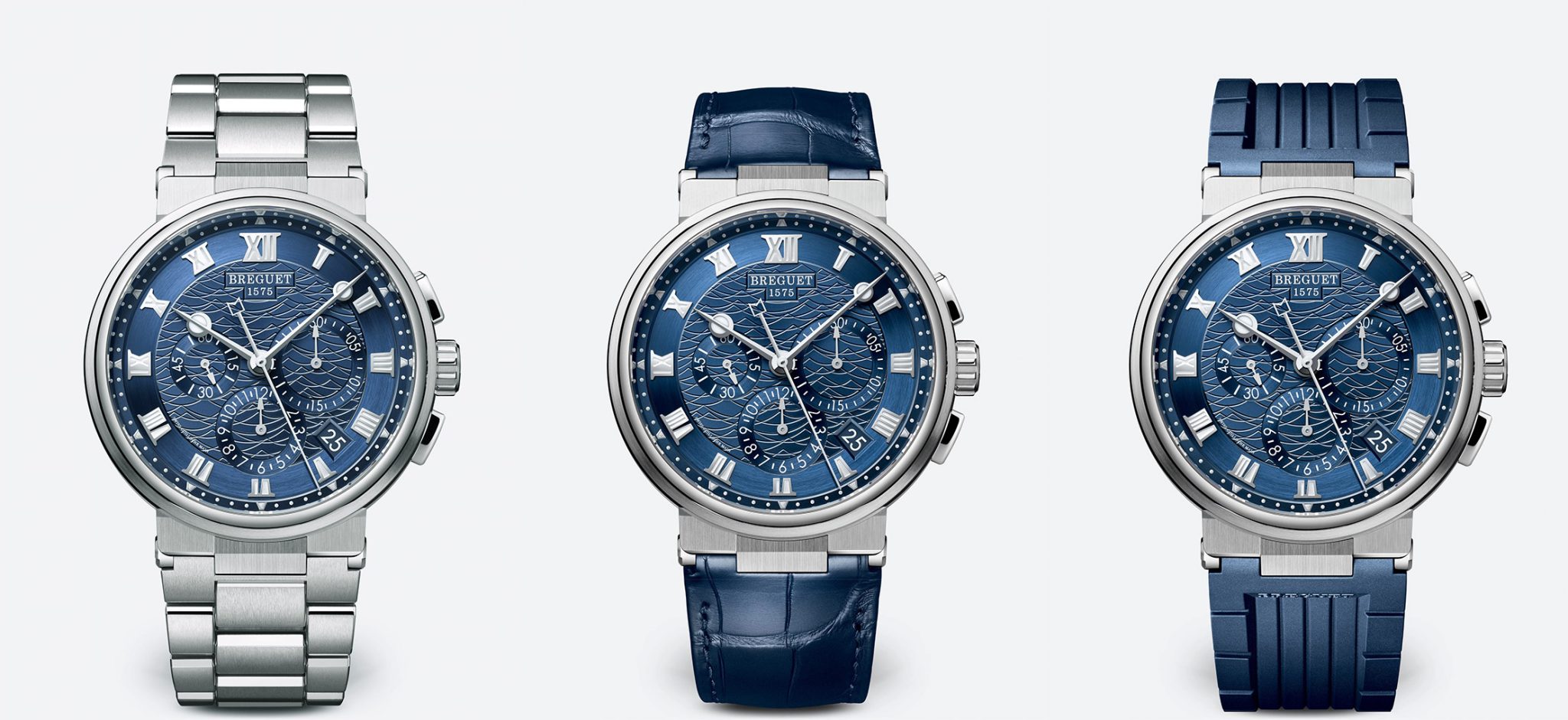
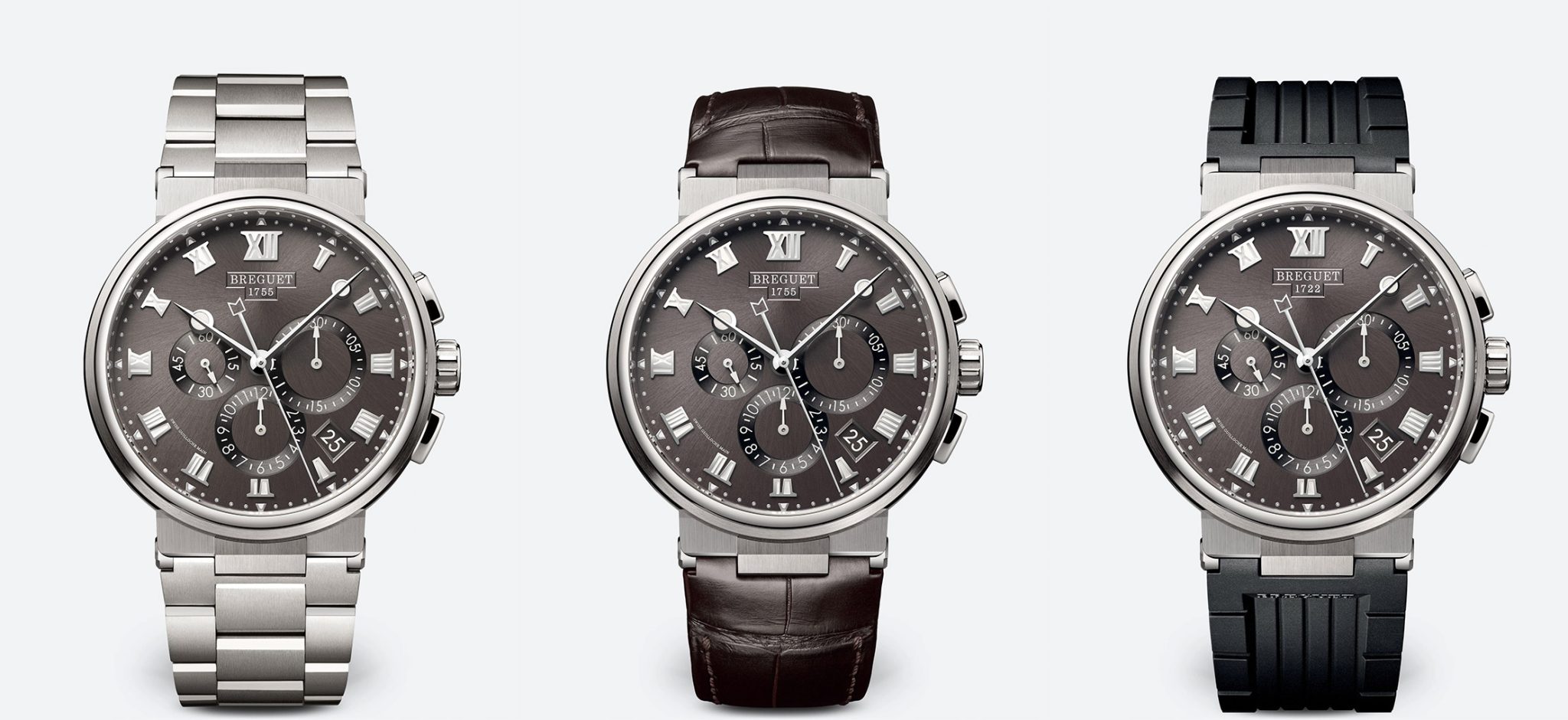
Marine Chronographe 5527 with titanium bracelet, leather strap, or rubber strap
Finally, the Marine Alarme Musicale 5547 in 18-carat rose gold with a silvered gold dial costs 37,470 euros with a leather or rubber strap – or 56,730 euros with the matching bracelet. Once again, the same prices apply to the white-gold versions with a blue-coloured gold dial. Last but not least, the titanium versions with a sunburst slate grey dial in gold cost 26,870 euros with a rubber or leather strap – or 29,280 euros with the bracelet.
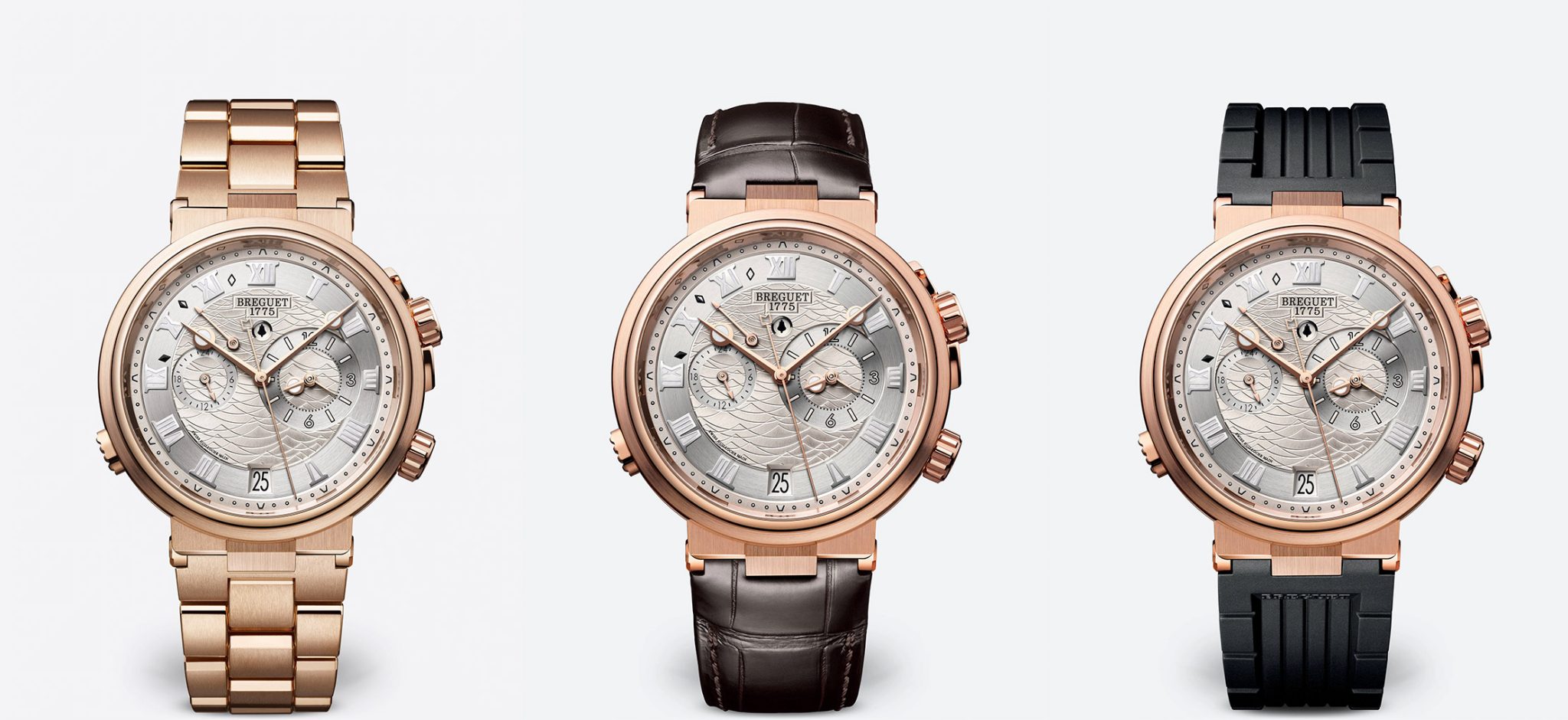
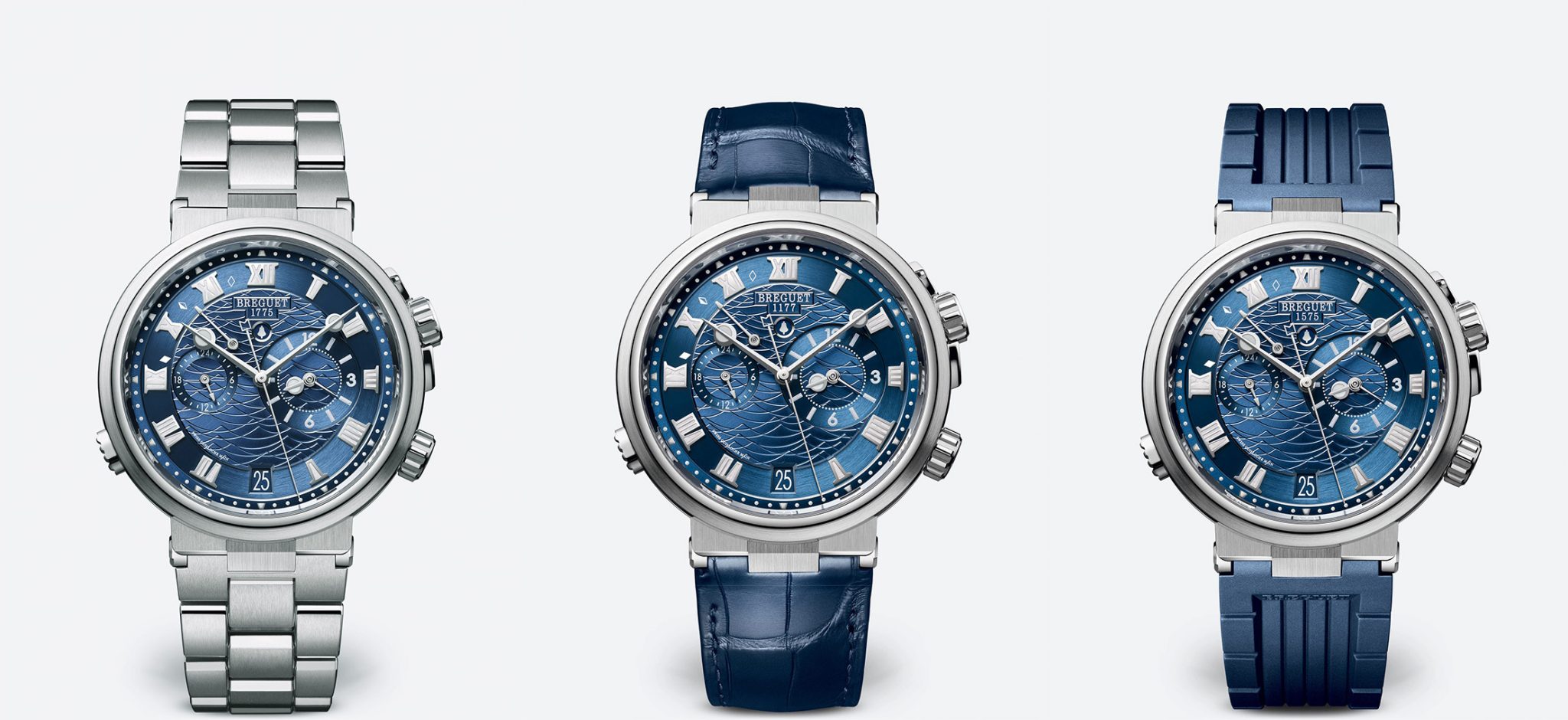
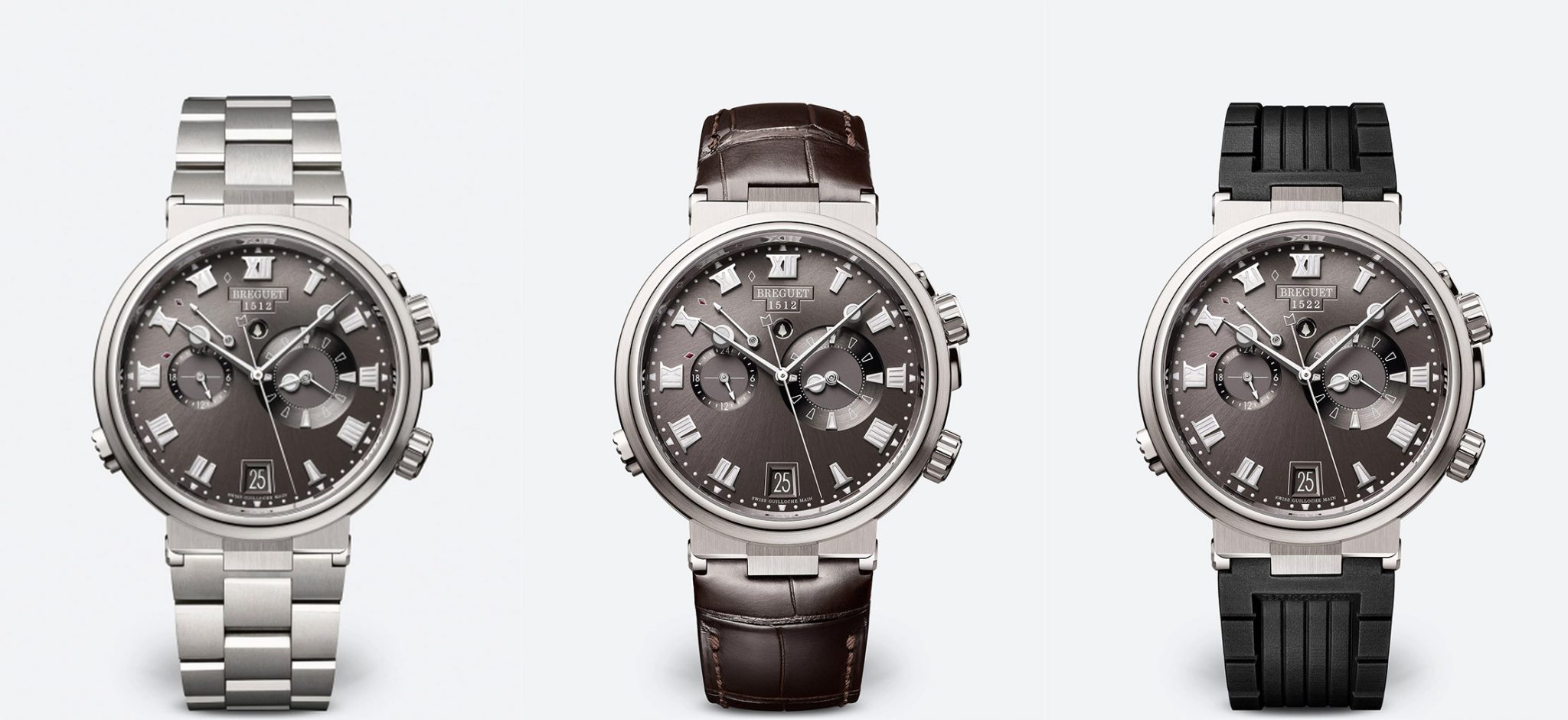
Marine Alarme Musicale 5547 in titanium
Looking to the Future
The fact that Breguet, a formidably historic brand, has created modern luxury sports watches with such a strong identity is laudable. Furthermore, there’s very little to dislike about the decisively sporty look provided by the universal option of bracelets for the Marine watches. The addition of precious metal bracelets also furthers the line’s reputation as robust, athletic and masculine, and are likely to appeal to a wider, possibly younger audience.
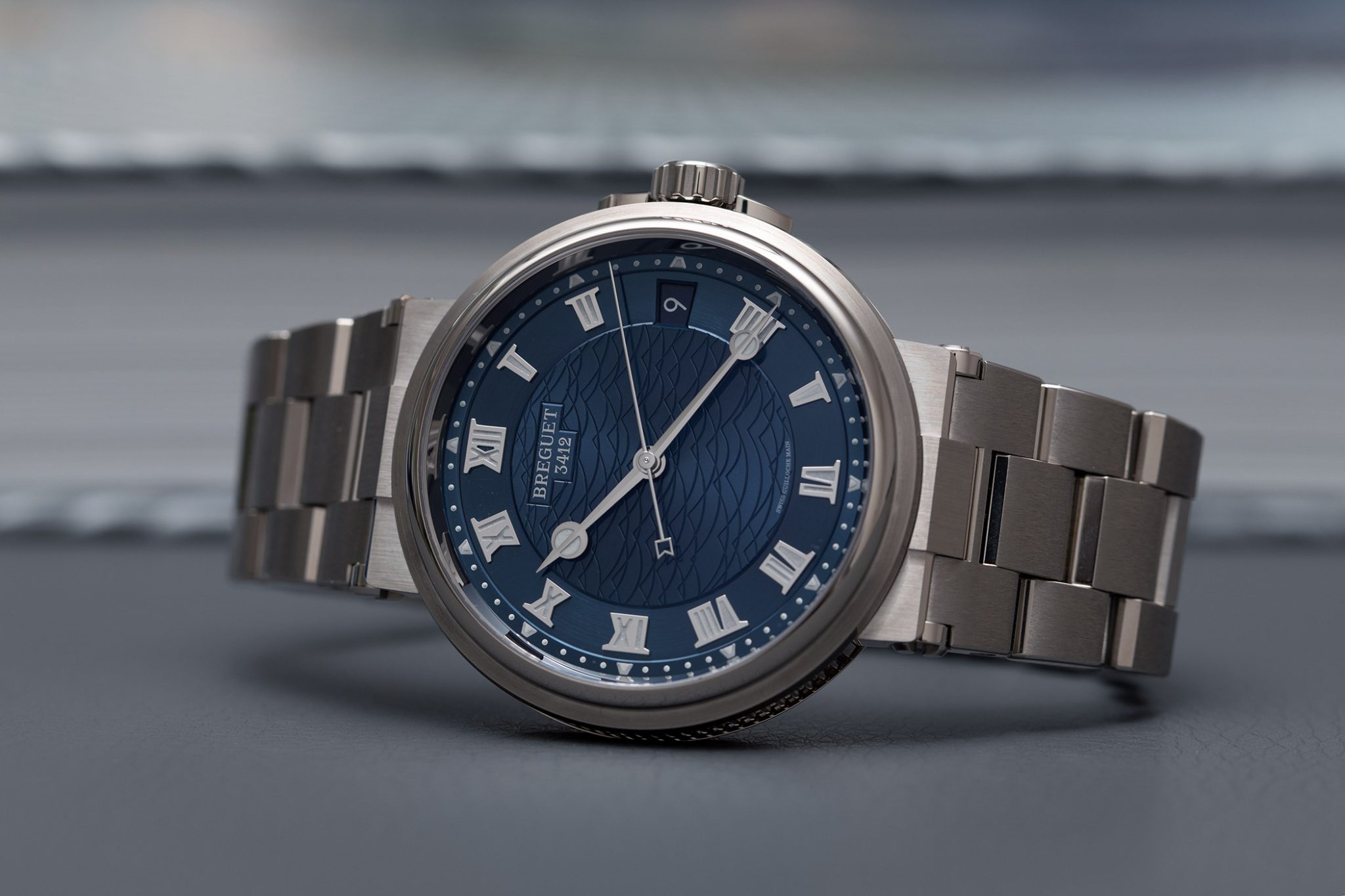
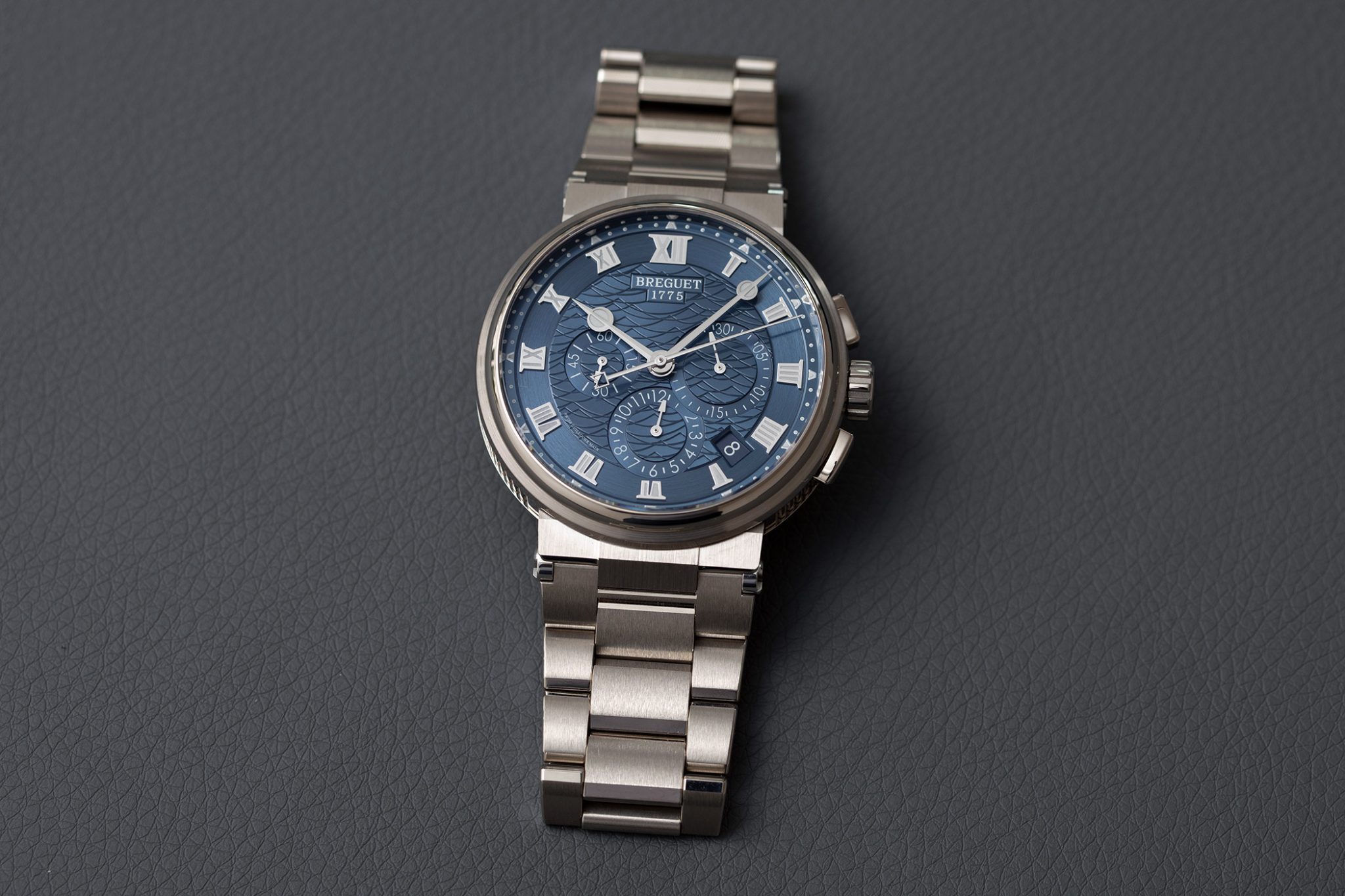
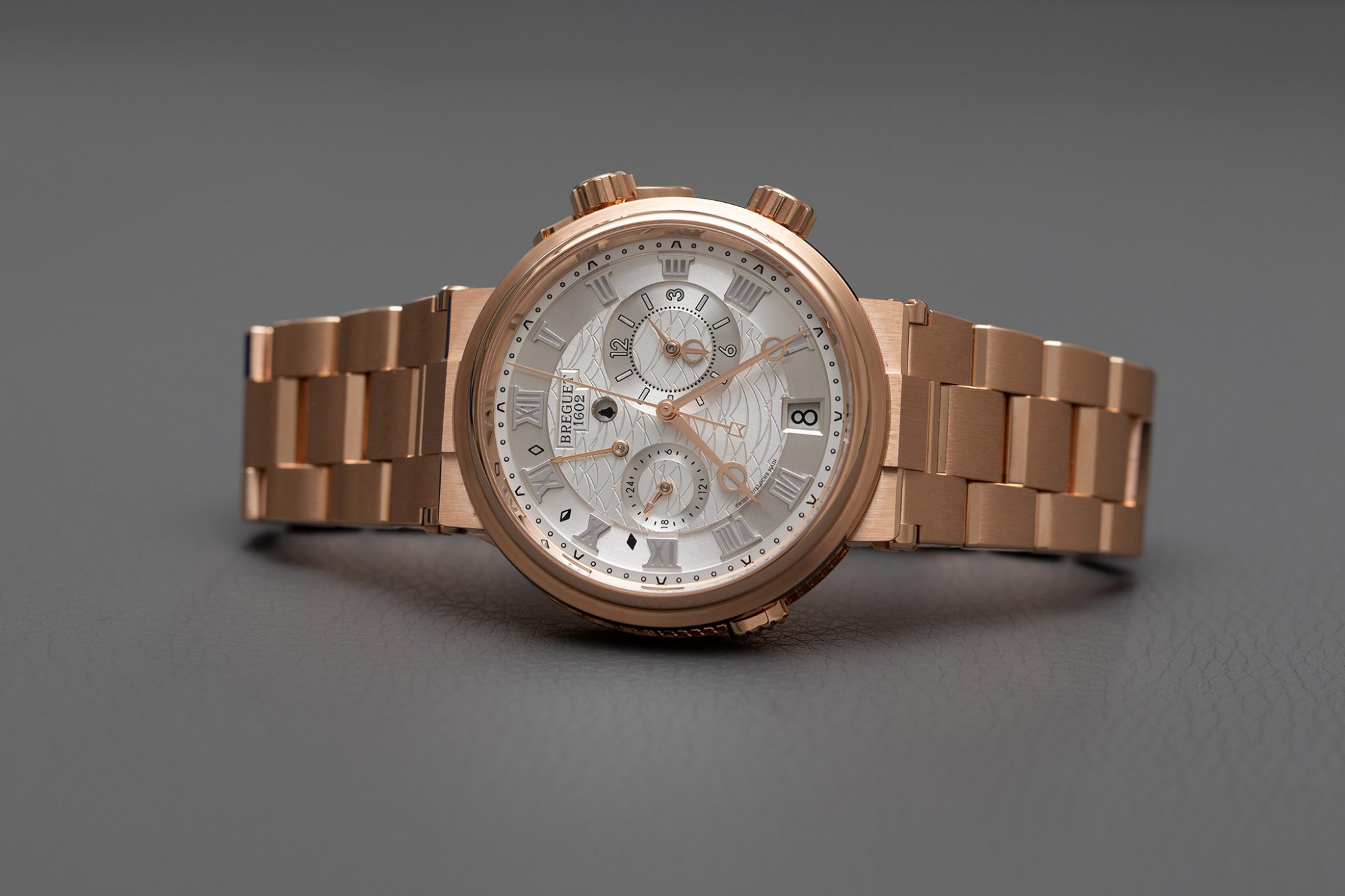
Marine Alarme Musicale 5547 in rose-gold (Ref. 5547BR/12/RZ0)
That said, if one were to be pernickety, it does make less sense for the rose-gold and white-gold Marine iterations to offer bracelets. Unlike titanium, the materials cannot boast a connection to a marine heritage. Rather, the manufacture’s introduction of the precious metal bracelets seems to have been a wise commercial move, which will result in pleasing its customers as it taps into the current sports watch trend of integrated bracelets. As can be surmised from the prices, the more expensive precious metal bracelets are likely to prove profitable. However, that’s not to say that the excellently executed bracelets won’t seduce you the minute that they are fastened onto your wrist.
Sources:
Bell, J. 2017. Marine Chronometers At Greenwich: A Catalogue Of Marine Chronometers At The National Maritime Museum, Greenwich. London: Oxford University Press.
